
1EdTech Accessible Portable Item Protocol™ (APIP™): Technical Specification for QTIv2.1 Accessibility Features
Final Specification Version 1.0
Date Issued: 31 March 2014
Latest version: http://www.imsglobal.org/apip/
IPR and Distribution Notices
Recipients of this document are requested to submit, with their comments, notification of any relevant patent claims or other intellectual property rights of which they may be aware that might be infringed by any implementation of the specification set forth in this document, and to provide supporting documentation.
1EdTech draws attention to the fact that it is claimed that compliance with this specification may involve the use of Measured Progress U.S. patent 8,303,309. 1EdTech takes no position concerning the evidence, validity or scope of such patent rights. Measured Progress has assured 1EdTech that it is willing to license patent rights it owns or controls which would necessarily be infringed by any implementation of this specification to those licensees (Members and non-Members alike) desiring to implement this specification. The statement of Measured Progress to such effect has been filed with 1EdTech. Information regarding a Reasonable and Non-Discriminatory - Zero cost (RAND-Z) license may be obtained from Measured Progress at http://www.measuredprogress.org/ipr-apip.
Attention is also drawn to the possibility that some of the elements of this specification may be the subject of patent rights other than those identified above. 1EdTech shall not be responsible for identifying any or all such patent rights. 1EdTech takes no position regarding the validity or scope of any intellectual property or other rights that might be claimed to pertain to the implementation or use of the technology described in this document or the extent to which any license under such rights might or might not be available; neither does it represent that it has made any effort to identify any such rights. Information on 1EdTech’s procedures with respect to rights in 1EdTech specifications can be found at the 1EdTech Intellectual Property Rights web page: http://www.imsglobal.org/ipr/imsipr_policyFinal.pdf.
Copyright © 2012-14 1EdTech Consortium. All Rights Reserved.
Use of this specification to develop products or services is governed by the license with 1EdTech found on the 1EdTech website: http://www.imsglobal.org/speclicense.html.
Permission is granted to all parties to use excerpts from this document as needed in producing requests for proposals.
The limited permissions granted above are perpetual and will not be revoked by 1EdTech or its successors or assigns.
THIS SPECIFICATION IS BEING OFFERED WITHOUT ANY WARRANTY WHATSOEVER, AND IN PARTICULAR, ANY WARRANTY OF NONINFRINGEMENT IS EXPRESSLY DISCLAIMED. ANY USE OF THIS SPECIFICATION SHALL BE MADE ENTIRELY AT THE IMPLEMENTER'S OWN RISK, AND NEITHER THE CONSORTIUM, NOR ANY OF ITS MEMBERS OR SUBMITTERS, SHALL HAVE ANY LIABILITY WHATSOEVER TO ANY IMPLEMENTER OR THIRD PARTY FOR ANY DAMAGES OF ANY NATURE WHATSOEVER, DIRECTLY OR INDIRECTLY, ARISING FROM THE USE OF THIS SPECIFICATION.
Public contributions, comments and questions can be posted here: http://www.imsglobal.org/community/forum/categories.cfm?catid=110
© 2014 1EdTech Consortium, Inc.
All Rights Reserved.
The 1EdTech Logo, Accessible Portable Item Protocol (APIP), and Question and Test Interoperability (QTI) are trademarks of the 1EdTech Consortium, Inc. in the United States and/or other countries.
Documents Name: 1EdTech APIP Technical Specification for QTIv2.1 Accessibility Features v1.0 Final Specification –
Revision: 31 March 2014
1 Introduction
1.1 Scope and Context
This document contains the technical specification of some of the assessment accessibility features created for the Accessible Portable Item Protocol (APIP™) Standard. The APIP Standard provides assessment programs and question item developers a data model for standardizing the file format of digital test items. When applied properly, the APIP standards accomplish two important goals. First, the APIP standards allow digital test items to be ported across APIP compliant test item banks. Second, the APIP standards provide a test delivery interface with all the information and resources required to make a test item accessible for students with a variety of disabilities and special needs.
The APIP standards build on the 1EdTech Question and Test Interoperability™ (QTI™) v2.1 [QTI, 12a] and the 1EdTech Access For All Personal Needs & Preferences (AfA PNP) v2.0 specifications. However, these do not provide all of the functionality required by APIP and so extensions have been created to both specifications. This document details the extensions to the QTI v2.1 Specification in terms of the new information model and the corresponding XML Schema Definition (XSD) binding. The associated best practises and examples are presented in [APIP, 14c].
1EdTech strongly encourages its members and the community to provide feedback to continue the evolution and improvement of the APIP standard. To join the 1EdTech developer and conformance certification community focused on APIP and QTI please visit the 1EdTech QTI/APIP Alliance online here: http://www.imsglobal.org/apip/index.html
Public contributions, comments and questions can be posted here: http://www.imsglobal.org/community/forum/categories.cfm?catid=110
1.2 Structure of this Document
The structure of the rest of this document is:
|
2. New Features by the APIP |
An overview of the new features and their relationship to the corresponding baseline 1EdTech specifications; |
|
3. QTI Information model Extension |
The information model description (using the 1EdTech unified modelling language platform independent model representation) of the imported extensions to the QTI v2.1 specification; |
|
4. QTI Extension Binding Description |
The binding description (using the 1EdTech UML platform specific model representation for XSDs) of the extensions to the QTI v2.1 specification; |
|
Appendix A The 1EdTech UML Profile Notation |
An explanation of the notational approach used in describing the new information models. |
1.3 Related Documents
[APIP, 14a] Accessible Portable Item Protocol (APIP) Technical Specification Overview v1.0 Final Specification, G.Driscoll, T.Hoffmann, W.Ostler, M.Russell and C.Smythe, 1EdTech, Inc., March 2014.
[APIP, 14b] Accessible Portable Item Protocol (APIP) Technical Specification v1.0 Final Specification, G.Driscoll, T.Hoffmann, W.Ostler, M.Russell and C.Smythe, 1EdTech, Inc., March 2014.
[APIP, 14c] Accessible Portable Item Protocol (APIP) Best Practices & Implementation Guide v1.0 Final Specification, G.Driscoll, T.Hoffmann, W.Ostler, M.Russell and C.Smythe, 1EdTech, Inc., March 2014.
[CSS3Speech, 12] W3C CSS Speech Module (Candidate Recommendation)
http://www.w3.org/TR/css3-speech/, March 2012
[PLS, 08] W3C Pronunciation Lexicon Standard (PLS) Version 1.0
http://www.w3.org/TR/pronunciation-lexicon/, October 2008
[QTI, 12a] 1EdTech Question & Test Interoperability Assessment Test, Section and Item Information Model v2.1 Final Specification, S.Lay and P.Gorissen, 1EdTech Inc., August 2012.
[QTI, 12b] 1EdTech Question & Test Interoperability XML Binding v2.1 Final Specificaiton, S.Lay and P.Gorissen, 1EdTech, Inc., August 2012.
[QTI, 12c] 1EdTech Question & Test Interoperability Implementation Guide v2.1 Final Specification, S.Lay and P.Gorissen, 1EdTech, Inc., August 2012.
[QTI, 12d] 1EdTech Question & Test Interoperability Conformance Guide v2.1 Final Specification, S.Lay and P.Gorissen, 1EdTech, Inc., August 2012.
[QTI, 12e] 1EdTech Question & Test Interoperability Metadata and Usage Data v2.1 Final Specification, S.Lay and P.Gorissen, 1EdTech, Inc., August 2012.
[QTI, 12f] 1EdTech Question & Test Interoperability Migration Guide v2.1 Final Specification, S.Lay and P.Gorissen, 1EdTech, Inc., August 2012.
[QTI, 12g] 1EdTech Question & Test Interoperability Overview v2.1 Final Specification, S.Lay and P.Gorissen, 1EdTech, Inc., August 2012.
[QTI, 12h] 1EdTech Question & Test Interoperability Results Reporting v2.1 Final Specification, S.Lay and P.Gorissen, 1EdTech, Global Inc., August 2012.
[SSML, 11] W3C Speech Synthesis Markup Language (SSML) Version 1.1.
http://www.w3.org/TR/speech-synthesis11/
1.4 Acronyms
AfA PNP Access for All Personal Needs & Preferences
APIP Accessible Portable Item Protocol
ASL American Sign Language
CP Content Packaging
CSS Cascading Stylesheet
HTML Hypertext Mark-up Language
I-BAT 1EdTech Binding Auto-generation Toolkit
1EdTech 1EdTech Consortium
LUID Locally Unique Identifier
PIM Platform Independent Model
PLS Pronunciation Lexicon Standard
PSM Platform Specific Model
QTI Question & Test Interoperability
SSML Speech Synthesis Mark-up Language
UML Unified Modeling Language
XML Exchange Mark-up Language
XSD XML Schema Definition
2 New Features Required by APIP
The original 1EdTech QTI specifications do not address content accessibility except in the form of best practice recommendations for HTML. Therefore, support for accessibility in the form of special content requires extensions to the QTI and the corresponding XSD. These extensions will be ignored by non-APIP enabled systems.
The relationship between the bindings of the new features with the original specifications is shown schematically in Figure 2.1. The new features are realised as their own XSD (shown as the XSD at the base of the diagram). This new XSD is used to extend the functionality of the original/profiled QTI XSD (shown as the middle feature in the diagram) and these are used to validate the corresponding data file instances.
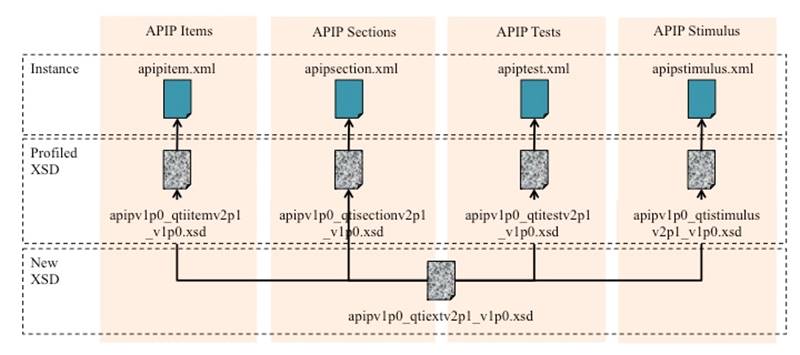
Figure 2.1 Schematic representation of the relationship between the original and new features.
The APIP Accessibility Information component contains two categories of information that specify supplementary information that a test delivery engine may present to a test taker based on his or her access need. The first category of information defines elements within shared stimulus, item, section and test content, and is used to mark up the content for which supplementary information may be provided. Content elements are defined by referencing specific blocks of text, media files, or parts of a table that appear within the Item Content Information component. Content elements can range in size from a single character to all content contained in the Item Content Information component. In addition, a piece of stimulus content may be referenced by multiple item content definitions.
The second category of information contained in the Accessibility Information component specifies the supplementary information that is to be presented to test takers with a specific access need. Supplementary information falls into two broad categories, namely alternate representations of content and additional information. Alternate representations include presentation of an item element in audio, Braille, tactile, or signed form. Additional information includes key word definitions, key word translations, flags, and scaffold supports.
This document describes the functionality and development of the new XSD that represent this new functionality. The points where the APIP extensions are used in the QTIv2.1 are explicitly identified in the QTIv2.1 specification (externally name-spaced features). The profiled versions of the QTIv2.1 specification used by APIP do not add any further points of use of the APIP features.
3 Information Model Extension
3.1 APIPAccessibility Class
The PIM for the APIPAccessibility class is shown in Figure 3.1.
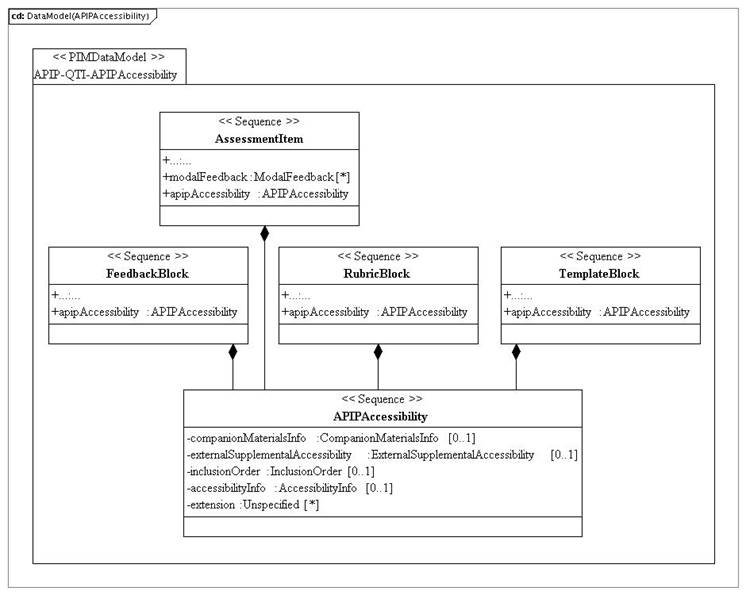
Figure 3.1 APIPAccessibility class.
Table 3.1 The ‘AssessmentItem/FeedbackBlock/RubricBlock/TemplateBlock’ classes.
|
Descriptor |
Definition |
|---|---|
|
Class name |
AssessmentItem, FeedbackBlock, RubricBlock, TemplateBlock |
|
Class type |
Container (Sequence) |
|
Parents |
Root |
|
Children |
[ …, apipAccessibility ], ordered |
|
Description |
These are the root containers for APIP information within QTIv2.1. See the 1EdTech Question & Test Interoperability v2.1 specification [QTI, 2012a]. |
3.1.1 ‘apipAccessibility’ Attribute Description
Table 3.2 The ‘apipAccessibility’ attribute for the QTIv2.1 classes.
|
Descriptor |
Definition |
|---|---|
|
Attribute name |
apipAccessibility |
|
Data type |
APIPAccessibiity |
|
Value space |
Container |
|
Multiplicity |
[0..1] |
|
Description |
This is the top-level container for the APIP material that is used to extend the various QTI features. This attribute is a named extension feature in the QTIv2.1 specification. |
3.1.2 ‘APIPAccessibility’ Class Description
Table 3.3 The ‘APIPAccessibility’ class.
|
Descriptor |
Definition |
|---|---|
|
Class name |
APIPAccessibility |
|
Class type |
Container (Sequence) |
|
Parents |
AssessmentItem (defined in the 1EdTech QTI Information Model v2.1). |
|
Children |
[ companionMaterialsInfo, externalSupplementalAccessibility, inclusionOrderInfo, accessibilityInfo, extension ], ordered |
|
Description |
This is the root container for all of the APIP QTI Accessibility information that is required to extend the base 1EdTech QTIv2.1 specification. This class is the type for the attribute ‘apipAccessibility’ that is used to extend the QTI data model and in particular the AssessmentItem class. |
3.1.3 ‘CompanionMaterialsInfo’ Attribute Description
Table 3.4 The ‘companionMaterialsInfo’ attribute for the APIPAccessibility class.
|
Descriptor |
Definition |
|---|---|
|
Attribute name |
companionMaterialsInfo |
|
Data type |
CompanionMaterialsInfo |
|
Value space |
Container |
|
Multiplicity |
[0..1] |
|
Description |
This identifies the set of companion materials that should be used when answering the questions presented during the assessment. A number of different types of materials can be required in various combinations. |
3.1.4 ‘ExternalSupplementalAccessibility’ Attribute Description
Table 3.5 The ‘externalSupplementalAccessibility’ attribute for the APIPAccessibility class.
|
Descriptor |
Definition |
|---|---|
|
Attribute name |
externalSupplementalAccessibility |
|
Data type |
ExternalSupplementalAccessibility |
|
Value space |
Container |
|
Multiplicity |
[0..1] |
|
Description |
This identifies the set of supplemental information that must be used to provide further guidance on how to render the alternative accessibility information e.g. the use of the Pronunciation Lexicon Standard (PLS), etc. |
3.1.5 ‘InclusionOrder’ Attribute Description
Table 3.6 The ‘inclusionOrder’ attribute for the APIPAccessibility class.
|
Descriptor |
Definition |
|---|---|
|
Attribute name |
inclusionOrder |
|
Data type |
InclusionOrder |
|
Value space |
Container |
|
Multiplicity |
[0..1] |
|
Description |
This is used to define the order that the assessment information is to be presented to a learner for a number of different accessibility preferences. |
3.1.6 ‘AccessibilityInfo’ Attribute Description
Table 3.7 The ‘accessibilityInfo’ attribute for the APIPAccessibility class.
|
Descriptor |
Definition |
|---|---|
|
Attribute name |
accessibilityInfo |
|
Data type |
AccessibilityInfo |
|
Value space |
Container |
|
Multiplicity |
[0..1] |
|
Description |
This is the new accessibility content that is defined to enable the range of supported accessibility options to reconfigure the assessment content. This content augments the original content that is defined for the associated QTI feature. |
3.1.7 ‘Extension’ Attribute Description
Table 3.8 The ‘extension’ attribute for the APIPAccessibility class.
|
Descriptor |
Definition |
|---|---|
|
Attribute name |
extension |
|
Data type |
Unspecified |
|
Value space |
Defined in terms of how the Information Model is realised by a binding. |
|
Multiplicity |
[0..unbounded], unordered |
|
Description |
This is a placeholder. It informs bindings of this Information Model as to the valid locations for the inclusion that extend the parent class. The form of the extension is binding dependent. |
3.2 CompanionMaterialsInfo Class
The PIM for the CompanionMaterialsInfo class is shown in Figure 3.2.
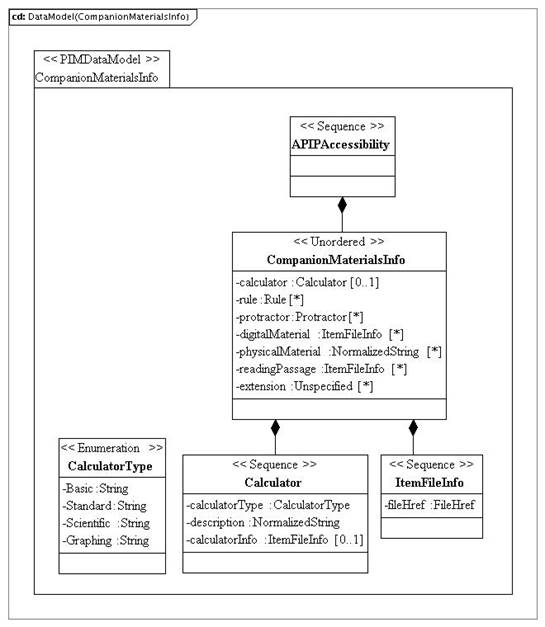
Figure 3.2 CompanionMaterialsInfo class.
Table 3.9 The ‘CompanionMaterialsInfo’ class.
|
Descriptor |
Definition |
|---|---|
|
Class name |
CompanionMaterialsInfo |
|
Class type |
Container (Sequence) |
|
Parents |
APIPAccessibility |
|
Children |
[ calculator, rule, protractor, digitalMaterial, physicalMaterial, readingPassage, extension ], ordered |
|
Description |
This is the container for the information about the companion materials that are available to a learner undertaking the assessment. |
3.2.1 ‘Calculator’ Attribute Description
Table 3.10 The ‘calculator’ attribute for the CompanionMaterialsInfo class.
|
Descriptor |
Definition |
|---|---|
|
Attribute name |
calculator |
|
Data type |
Calculator |
|
Value space |
Container |
|
Multiplicity |
[0..1] |
|
Description |
This refers to the information that is available about the calculator that is permitted/required for use in the assessment. |
3.2.2 ‘Rule’ Attribute Description
Table 3.11 The ‘rule’ attribute for the CompanionMaterialsInfo class.
|
Descriptor |
Definition |
|---|---|
|
Attribute name |
rule |
|
Data type |
Rule |
|
Value space |
Container |
|
Multiplicity |
[0..*] |
|
Description |
This refers to the information that is available about the Rules that are permitted/required for use in the assessment. |
3.2.3 ‘Protractor’ Attribute Description
Table 3.12 The ‘protractor’ attribute for the CompanionMaterialsInfo class.
|
Descriptor |
Definition |
|---|---|
|
Attribute name |
protractor |
|
Data type |
Protractor |
|
Value space |
Container |
|
Multiplicity |
[0..*] |
|
Description |
This refers to the information that is available about the protractors that are permitted/required for use in the assessment. |
3.2.4 ‘DigitalMaterial’ Attribute Description
Table 3.13 The ‘digitalMaterial’ attribute for the CompanionMaterialsInfo class.
|
Descriptor |
Definition |
|---|---|
|
Attribute name |
digitalMaterial |
|
Data type |
ItemFileInfo |
|
Value space |
Container |
|
Multiplicity |
[0..*] |
|
Description |
This refers to the external digital material that is available for use with the assessment e.g. a map, formula sheet, etc. The digital material is available at the location identified by a URL. |
3.2.5 ‘PhysicalMaterial’ Attribute Description
Table 3.14 The ‘physicalMaterial’ attribute for the CompanionMaterialsInfo class.
|
Descriptor |
Definition |
|---|---|
|
Attribute name |
physicalMaterial |
|
Data type |
NormalizedString (See Table A1.1) |
|
Value space |
Normalized string. |
|
Multiplicity |
[0..*] |
|
Description |
This refers to the external physical material that is available for use with the assessment e.g. a map, formula sheet, etc. The associated text can be used to describe the material and where and when it is to be used. |
3.2.6 ‘ReadingPassage’ Attribute Description
Table 3.15 The ‘readingPassage’ attribute for the CompanionMaterialsInfo class.
|
Descriptor |
Definition |
|---|---|
|
Attribute name |
readingPassage |
|
Data type |
ItemFileInfo |
|
Value space |
Container |
|
Multiplicity |
[0..1] |
|
Description |
This refers to the information that is available about the reading passage that is permitted/required for use in the assessment. The reading passage is available at the location identified by a URL. |
3.2.7 ‘Extension’ Attribute Description
Table 3.16 The ‘extension’ attribute for the CompanionMaterialsInfo class.
|
Descriptor |
Definition |
|---|---|
|
Attribute name |
extension |
|
Data type |
Unspecified |
|
Value space |
Defined in terms of how the Information Model is realised by a binding. |
|
Multiplicity |
[0..unbounded], unordered |
|
Description |
This is a placeholder. It informs bindings of this Information Model as to the valid locations for the inclusion that extend the parent class. The form of the extension is binding dependent. |
3.2.8 ‘Calculator’ Class
The PIM for the Calculator class is shown in Figure 3.2.
Table 3.17 The ‘Calculator’ class.
|
Descriptor |
Definition |
|---|---|
|
Class name |
Calculator |
|
Class type |
Container (Sequence) |
|
Parents |
CompanionMaterialsInfo |
|
Children |
[ calculatorType, description, calculatorInfo ], ordered |
|
Description |
This is the container for the information about the calculator that is required/permitted for use by the learner undertaking the assessment. |
3.2.8.1 ‘CalculatorType’ Attribute Description
Table 3.18 The ‘calculatorType’ attribute for the Calculator class.
|
Descriptor |
Definition |
|---|---|
|
Attribute name |
calculatorType |
|
Data type |
Enumeration |
|
Value space |
Enumeration set of: { Basic | Standard | Scientific | Graphing } |
|
Multiplicity |
[1] |
|
Description |
The definition of the set of permitted calculators for use with the assessment. |
3.2.8.2 ‘Description’ Attribute Description
Table 3.19 The ‘description’ attribute for the Calculator class.
|
Descriptor |
Definition |
|---|---|
|
Attribute name |
description |
|
Data type |
NormalizedString |
|
Value space |
Normalized string (see Appendix A). |
|
Multiplicity |
[1] |
|
Description |
Provides for a human readable description of the functionality/capability of the calculator that is available to the learner. |
3.2.8.3 ‘CalculatorInfo’ Attribute Description
Table 3.20 The ‘calculatorInfo’ attribute for the Calculator class.
|
Descriptor |
Definition |
|---|---|
|
Attribute name |
calculatorInfo |
|
Data type |
ItemInfoFile |
|
Value space |
Container |
|
Multiplicity |
[0..1] |
|
Description |
This refers to the access to the calculator itself that is permitted/required for use in the assessment. The calculator is available at the location identified by a URI. |
3.2.9 ‘ItemFileInfo’ Class
The PIM for the ItemFile class is shown in Figure 3.2.
Table 3.21 The ‘ItemFileInfo’ class.
|
Descriptor |
Definition |
|---|---|
|
Class name |
ItemInfoFile |
|
Class type |
Container (Sequence) |
|
Parents |
CompanionMaterialsInfo |
|
Children |
[ fileHref ] |
|
Description |
This is the container for information about an external file that contains information to be made available to the learner. |
3.2.9.1 ‘FileHref’ Attribute Description
Table 3.22 The‘fileHref’ attribute for the ItemFileInfo class.
|
Descriptor |
Definition |
|---|---|
|
Attribute name |
fileHref |
|
Data type |
FileHref |
|
Value space |
Normalized String (see Appendix A) containing a URI. |
|
Multiplicity |
[1] |
|
Description |
This is the URI for the associated content file. |
3.3 Rule Class
The PIM for the Rule class is shown in Figure 3.3.
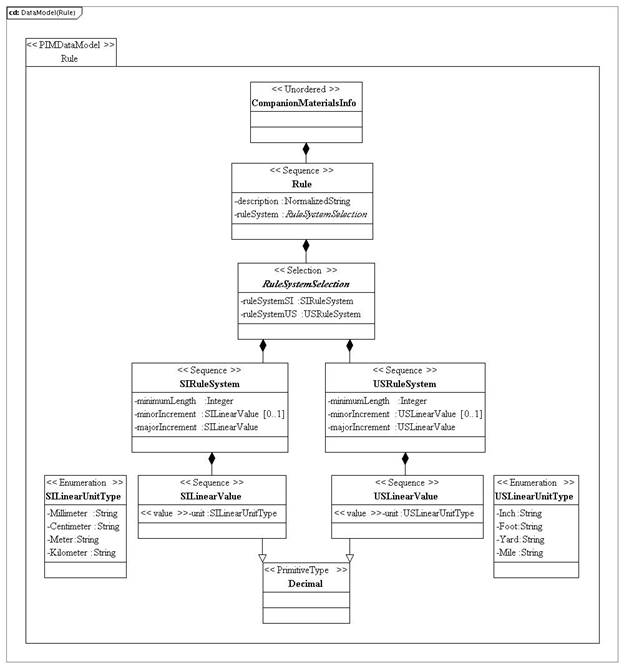
Figure 3.3 Rule class
Table 3.23 The ‘Rule’ class.
|
Descriptor |
Definition |
|---|---|
|
Class name |
Rule |
|
Class type |
Container (Sequence) |
|
Parents |
CompanionMaterials |
|
Children |
[ description, ( ruleSystemSI | ruleSystemUS ) ], ordered with selection |
|
Description |
The container for the information about the rule that is permitted/required for use in the assessment. The rule is defined in terms of SI or US units. |
3.3.1 ‘Description’ Attribute Description
Table 3.24 The ‘description’ attribute for the Rule class.
|
Descriptor |
Definition |
|---|---|
|
Attribute name |
description |
|
Data type |
Normalized String (see Appendix A). |
|
Value space |
Normalized string. |
|
Multiplicity |
[1] |
|
Description |
Provides for a human readable description of the functionality/capability of the rule that is available to the learner. |
3.3.2 ‘RuleSystemSI’ Attribute Description
Table 3.25 The ‘ruleSystemSI’ attribute for the Rule class.
|
Descriptor |
Definition |
|---|---|
|
Attribute name |
ruleSystemSI |
|
Data type |
RuleSystemSI |
|
Value space |
Container (Sequence) |
|
Multiplicity |
[1] |
|
Description |
The container for the information about the rule defined in terms of SI units. |
3.3.3 ‘RuleSystemUS’ Attribute Description
Table 3.26 The ‘ruleSystemUS’ attribute for the Rule class.
|
Descriptor |
Definition |
|---|---|
|
Attribute name |
ruleSystemUS |
|
Data type |
RuleSystemUS |
|
Value space |
Container (Sequence) |
|
Multiplicity |
[1] |
|
Description |
The container for the information about the rule defined in terms of US units. |
3.3.4 ‘SIRuleSystem’ Class
The PIM for the SIRuleSystem class is given in Figure 3.3.
Table 3.27 The ‘SIRuleSystem’ class.
|
Descriptor |
Definition |
|---|---|
|
Class name |
SIRuleSystem |
|
Class type |
Container (Sequence) |
|
Parents |
Rule |
|
Children |
[ minimumLength, minorIncrement, majorIncrement ], ordered |
|
Description |
The container for the information about the rule that is permitted/required for use in the assessment. The rule is defined in terms of SI units. |
3.3.5 ‘MinimumLength’ Attribute Description
Table 3.28 The ‘minimumLength’ attribute for the SIRuleSystem class.
|
Descriptor |
Definition |
|---|---|
|
Attribute name |
minimumLength |
|
Data type |
Integer |
|
Value space |
1 ≤ minimumLength ≤ 216-1 |
|
Multiplicity |
[1] |
|
Description |
This is the container for the minimum length of the rule. The length is defined as a multiple of the unit of the major increment. |
3.3.6 ‘MinorIncrement’ Attribute Description
Table 3.29 The ‘minorIncrement’ attribute for the SIRuleSystem class.
|
Descriptor |
Definition |
|---|---|
|
Attribute name |
minorIncrement |
|
Data type |
SILinearValue |
|
Value space |
Container (Sequence) |
|
Multiplicity |
[0..1] |
|
Description |
This is the container for the length of the minor increment for the rule. |
3.3.7 ‘MajorIncrement’ Attribute Description
Table 3.30 The ‘majorIncrement’ attribute for the SIRuleSystem class.
|
Descriptor |
Definition |
|---|---|
|
Attribute name |
majorIncrement |
|
Data type |
SILinearValue |
|
Value space |
Container (Sequence) |
|
Multiplicity |
[1] |
|
Description |
This is the container for the length of the major increment for the rule. |
3.3.8 ‘SILinearValue’ Class
The PIM for the SILinearValue class is shown in Figure 3.3.
Table 3.31 The ‘SILinearValue’ class.
|
Descriptor |
Definition |
|---|---|
|
Class name |
LinearValue |
|
Class type |
Container (Sequence) |
|
Parents |
Rule |
|
Children |
[ unit ], ordered |
|
Value space |
Decimal [0.0 ≤ x ≤ 1000.0] |
|
Description |
The container for the information about the increment (length and unit) of a Rule. The value is the length in the associated type of unit. |
3.3.8.1 ‘Unit’ Attribute Description
Table 3.32 The ‘unit’ attribute for the SILinearValue class.
|
Descriptor |
Definition |
|---|---|
|
Attribute name |
unit |
|
Data type |
Enumeration. |
|
Value space |
Enumeration set of: { Millimeter | Centimeter | Meter | Kilometer } |
|
Multiplicity |
[1] |
|
Description |
This defines the type unit of length that are permitted for the rule. |
3.3.9 ‘USRuleSystem’ Class
The PIM for the USRuleSystem class is given in Figure 3.3.
Table 3.33 The ‘USRuleSystem’ class.
|
Descriptor |
Definition |
|---|---|
|
Class name |
USRuleSystem |
|
Class type |
Container (Sequence) |
|
Parents |
Rule |
|
Children |
[ minimumLength, minorIncrement, majorIncrement ], ordered |
|
Description |
The container for the information about the rule that is permitted/required for use in the assessment. The rule is defined in terms of US units. |
3.3.10 ‘MinimumLength’ Attribute Description
Table 3.34 The ‘minimumLength’ attribute for the USRuleSystem class.
|
Descriptor |
Definition |
|---|---|
|
Attribute name |
minimumLength |
|
Data type |
Integer |
|
Value space |
1 ≤ minimumLength ≤ 216-1 |
|
Multiplicity |
[1] |
|
Description |
This is the container for the minimum length of the rule. The length is defined as a multiple of the unit of the major increment. |
3.3.11 ‘MinorIncrement’ Attribute Description
Table 3.35 The ‘minorIncrement’ attribute for the USRuleSystem class.
|
Descriptor |
Definition |
|---|---|
|
Attribute name |
minorIncrement |
|
Data type |
USLinearValue |
|
Value space |
Container (Sequence) |
|
Multiplicity |
[0..1] |
|
Description |
This is the container for the length of the minor increment for the rule. |
3.3.12 ‘MajorIncrement’ Attribute Description
Table 3.36 The ‘majorIncrement’ attribute for the USRuleSystem class.
|
Descriptor |
Definition |
|---|---|
|
Attribute name |
majorIncrement |
|
Data type |
USLinearValue |
|
Value space |
Container (Sequence) |
|
Multiplicity |
[1] |
|
Description |
This is the container for the length of the major increment for the rule. |
3.3.13 ‘USLinearValue’ Class
The PIM for the USLinearValue class is shown in Figure 3.3.
Table 3.37 The ‘USLinearValue’ class.
|
Descriptor |
Definition |
|---|---|
|
Class name |
LinearValue |
|
Class type |
Container (Sequence) |
|
Parents |
Rule |
|
Children |
[ unit ], ordered |
|
Value space |
Decimal [0.0 ≤ x ≤ 1000.0] |
|
Description |
The container for the information about the increment (length and unit) of a Rule. The value is the length in the associated type of unit. |
3.3.13.1 ‘Unit’ Attribute Description
Table 3.38 The ‘unit’ attribute for the USLinearValue class.
|
Descriptor |
Definition |
|---|---|
|
Attribute name |
unit |
|
Data type |
Enumeration. |
|
Value space |
Enumeration set of: { Inch | Foot | Yard | Mile } |
|
Multiplicity |
[1] |
|
Description |
This defines the type unit of length that are permitted for the rule. |
3.4 Protractor Class
The PIM for the Protractor class is shown in Figure 3.4.
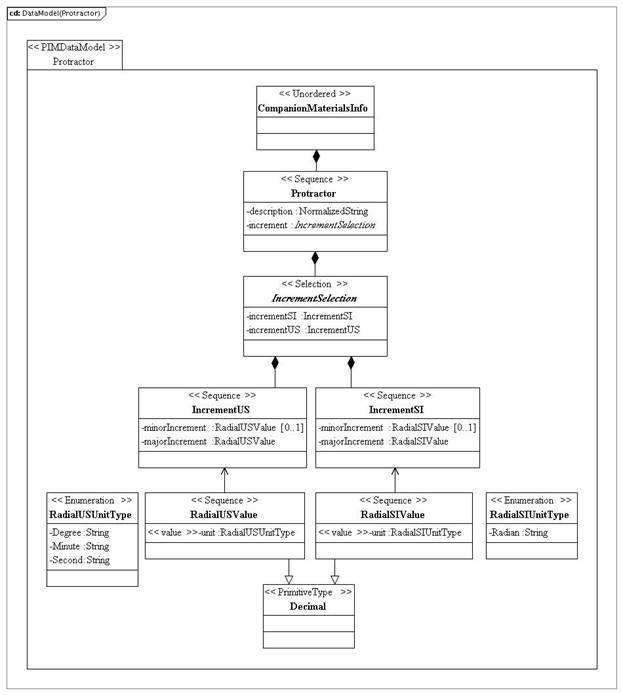
Figure 3.4 Protractor class.
Table 3.39 Description of the ‘Protractor’ class.
|
Descriptor |
Definition |
|---|---|
|
Class name |
Protractor |
|
Class type |
Container (Sequence) |
|
Parents |
CompanionMaterialsInfo |
|
Children |
[ description, ( incrementUS | incrementSI ) ], ordered and selection |
|
Description |
This is the container for the information about the permitted characteristics of the protractor companion material. |
3.4.1 ‘Description’ Attribute Description
Table 3.40 Description of the ‘description’ attribute for the Protractor class.
|
Descriptor |
Definition |
|---|---|
|
Attribute name |
description |
|
Data type |
Normalized String (see Appendix A). |
|
Value space |
Normalized string. |
|
Multiplicity |
[1] |
|
Description |
Provides for a human readable description of the functionality/capability of the protractor that is available to the learner. |
3.4.2 ‘IncrementSI’ Attribute Description
Table 3.41 The ‘incrementSI’ attribute for the Protractor class.
|
Descriptor |
Definition |
|---|---|
|
Attribute name |
incrementSI |
|
Data type |
IncrementSI |
|
Value space |
Container (Sequence) |
|
Multiplicity |
[1] |
|
Description |
The container for the information about the protractor defined in terms of SI units. |
3.4.3 ‘IncrementUS’ Attribute Description
Table 3.42 The ‘incrementUS’ attribute for the Protractor class.
|
Descriptor |
Definition |
|---|---|
|
Attribute name |
incrementUS |
|
Data type |
IncrementUS |
|
Value space |
Container (Sequence) |
|
Multiplicity |
[1] |
|
Description |
The container for the information about the protractor defined in terms of US units. |
3.4.4 ‘IncrementUS’ Class
The PIM for the IncrementUS class is given in Figure 3.4.
Table 3.43 The ‘IncrementUS’ class.
|
Descriptor |
Definition |
|---|---|
|
Class name |
IncrementUS |
|
Class type |
Container (Sequence) |
|
Parents |
Protractor |
|
Children |
[ minorIncrement, majorIncrement ], ordered |
|
Description |
The container for the information about the protractor that is permitted/required for use in the assessment. The rule is defined in terms of US units. |
3.4.5 ‘MinorIncrement’ Attribute Description
Table 3.44 Description of the ‘minorIncrement’ attribute for the IncrementUS class.
|
Descriptor |
Definition |
|---|---|
|
Attribute name |
minorIncrement |
|
Data type |
RadialUSValue |
|
Value space |
Container |
|
Multiplicity |
[0..1] |
|
Description |
This is the container for the information about the minor increments used on the protractor. |
3.4.6 ‘MajorIncrement’ Attribute Description
Table 3.45 Description of the ‘majorIncrement’ attribute for the IncrementUS class.
|
Descriptor |
Definition |
|---|---|
|
Attribute name |
increment |
|
Data type |
RadialUSValue |
|
Value space |
Container |
|
Multiplicity |
[0..1] |
|
Description |
This is the container for the information about the major increments used on the protractor. |
3.4.7 ‘RadialUSValue’ Class Description
Table 3.46 Description of the ‘RadialUSValue’ class.
|
Descriptor |
Definition |
|---|---|
|
Class name |
RadialUSValue |
|
Class type |
Container (Sequence) |
|
Parents |
IncrementUS |
|
Children |
[ unit ] |
|
Value space |
Decimal [0.0 ≤ x ≤ 359.99] – for unit of degree |
|
Description |
The container for the information about the increment size for a protractor. The value is in the associated type of unit. |
3.4.8 ‘Unit’ Attribute Description
Table 3.47 The ‘unit’ attribute for the RadialUSValue class.
|
Descriptor |
Definition |
|---|---|
|
Attribute name |
unit |
|
Data type |
Enumeration. |
|
Value space |
Enumeration set of: { Degree | Minute | Second } |
|
Multiplicity |
[1] |
|
Description |
This defines the US unit of radial increment that is used for the protractor. |
3.4.9 ‘IncrementSI’ Class
The PIM for the IncrementSI class is given in Figure 3.4.
Table 3.48 The ‘IncrementSI’ class.
|
Descriptor |
Definition |
|---|---|
|
Class name |
IncrementSI |
|
Class type |
Container (Sequence) |
|
Parents |
Protractor |
|
Children |
[ minorIncrement, majorIncrement ], ordered |
|
Description |
The container for the information about the protractor that is permitted/required for use in the assessment. The protractor is defined in terms of SI units. |
3.4.10 ‘MinorIncrement’ Attribute Description
Table 3.49 Description of the ‘minorIncrement’ attribute for the IncrementSI class.
|
Descriptor |
Definition |
|---|---|
|
Attribute name |
increment |
|
Data type |
RadialSIValue |
|
Value space |
Container |
|
Multiplicity |
[0..1] |
|
Description |
This is the container for the information about the minor increments used on the protractor. |
3.4.11 ‘MajorIncrement’ Attribute Description
Table 3.50 Description of the ‘majorIncrement’ attribute for the IncrementSI class.
|
Descriptor |
Definition |
|---|---|
|
Attribute name |
increment |
|
Data type |
RadialSIValue |
|
Value space |
Container |
|
Multiplicity |
[1] |
|
Description |
This is the container for the information about the major increments used on the protractor. |
3.4.12 ‘RadialSIValue’ Class Description
Table 3.51 Description of the ‘RadialSIValue’ class.
|
Descriptor |
Definition |
|---|---|
|
Class name |
RadialSIValue |
|
Class type |
Container (Sequence) |
|
Parents |
IncrementSI |
|
Children |
[ unit ] |
|
Value space |
Decimal [0.0 ≤ x ≤ 2p] |
|
Description |
The container for the information about the increment size for a protractor. The value is in the associated type of unit. |
3.4.13 ‘Unit’ Attribute Description
Table 3.52 The ‘unit’ attribute for the RadialUSValue class.
|
Descriptor |
Definition |
|---|---|
|
Attribute name |
unit |
|
Data type |
Enumeration. |
|
Value space |
Enumeration set of: { Radian } |
|
Multiplicity |
[1] |
|
Description |
This defines the SI unit of radial increment that is used for the protractor. |
3.5 ExternalSupplementalAccessibility Class
The PIM for the ExternalSupplementalAccessibility class is shown in Figure 3.5.
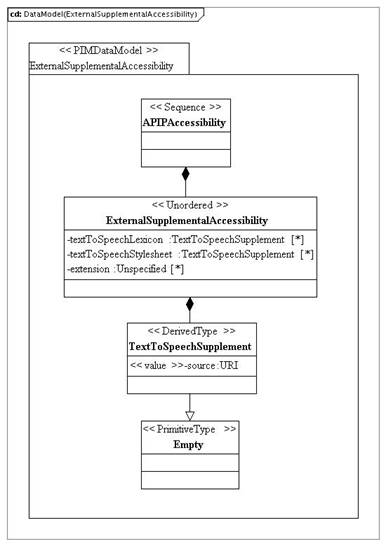
Figure 3.5 ExternalSupplementalAccessibility class.
Table 3.53 The ‘ExternalSupplementalAccessibility’ class.
|
Descriptor |
Definition |
|---|---|
|
Class name |
ExternalSupplementalAccessibility |
|
Class type |
Container (Unordered) |
|
Parents |
APIPAccessibility |
|
Children |
[textToSpeechLexicon, textToSpeechStylesheet , extension ], unordered |
|
Description |
This is the container for the supplemental information that can be used to provide further guidance on how to render the alternative accessibility information e.g. the use of the Pronunciation Lexicon Standard (PLS), etc. |
3.5.1 ‘TextToSpeechLexicon’ Attribute Description
Table 3.54 The ‘textToSpeechLexicon’ attribute for the ExternalSupplementalAccessibility class.
|
Descriptor |
Definition |
|---|---|
|
Attribute name |
textToSpeechLexicon |
|
Data type |
TextToSpeechLexicon |
|
Value space |
Container |
|
Multiplicity |
[0.. unbounded] |
|
Description |
This describes the application of the Pronunciation Lexicon Standard (PLS) to support the text to speech rendering of the alternative accessibility text. The PLS files linked via ‘textToSpeechLexicon’ are used by all spoken “audiences” e.g. “textOnly”, “nonvisual”, “textGraphics”, etc. The files must conform to a specific version of the PLS format, namely 1.0 (currently a W3C recommendation). |
3.5.2 ‘TextToSpeechStylesheet’ Attribute Description
Table 3.55 The ‘textToSpeechStylesheet’ attribute for the ExternalSupplementalAccessibility class.
|
Descriptor |
Definition |
|---|---|
|
Attribute name |
textToSpeechStylesheet |
|
Data type |
TextToSpeechStylesheet |
|
Value space |
Container |
|
Multiplicity |
[0.. unbounded] |
|
Description |
This is the information on the application of the CSS3 to support the text to speech rendering of the alternative accessibility text. CSS3 Speech files linked via ‘textToSpeechStyleSheet’ are to be used by all spoken “audiences” e.g. “textOnly”, “nonvisual”, “textGraphics”, etc. The linked files should conform to the CSS Speech Module specification, currently a W3C Candidate Recommendation. Non-speech-related visual style properties found within these CSS Speech files must be ignored by conforming systems. |
3.5.3 ‘Extension’ Attribute Description
Table 3.56 The ‘extension’ attribute for the ExternalSupplementalAccessibility class.
|
Descriptor |
Definition |
|---|---|
|
Attribute name |
extension |
|
Data type |
Unspecified |
|
Value space |
Defined in terms of how the Information Model is realised by a binding. |
|
Multiplicity |
[0..unbounded], unordered |
|
Description |
This is a placeholder. It informs bindings of this Information Model as to the valid locations for the inclusion that extend the parent class. The form of the extension is binding dependent. |
3.5.4 ‘TextToSpeechSupplement’ Class
The PIM for the TextToSpeechSupplement class is shown in Figure 3.5.
Table 3.57 The ‘TextToSpeechSupplement’ class.
|
Descriptor |
Definition |
|---|---|
|
Class name |
TextToSpeechSupplement |
|
Class type |
Container (DerivedType) |
|
Parents |
ExternalSupplementalAccessibility |
|
Children |
[ source ], unordered |
|
Description |
The source for the associated description file. |
3.5.4.1 ‘Source’ Attribute Description
Table 3.58 The ‘source’ attribute for the TextToSpeechSupplement class.
|
Descriptor |
Definition |
|---|---|
|
Attribute name |
source |
|
Data type |
URI |
|
Value space |
See Appendix A. |
|
Multiplicity |
[1] |
|
Description |
The URI for the associated text to speech supplemental accessibility information. |
3.6 InclusionOrder Class
The PIM for the InclusionOrder class is shown in Figure 3.6.
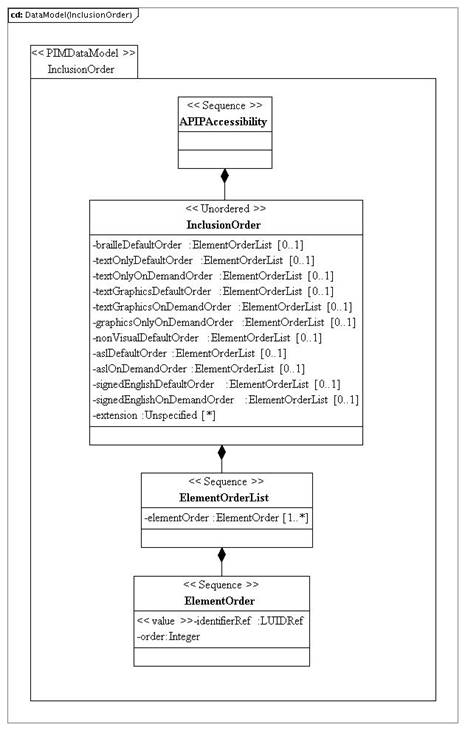
Figure 3.6 InclusionOrder class.
Table 3.59 The ‘InclusionOrder’ class.
|
Descriptor |
Definition |
|---|---|
|
Class name |
InclusionOrder |
|
Class type |
Container (Unordered) |
|
Parents |
APIPAccessibility |
|
Children |
[ brailleDefaultOrder, textOnlyDefaultOrder, textOnlyOnDemandOrder, textGraphicsDefaultOrder, textGraphicsOnDemandOrder, graphicsOnlyOnDemandOrder, nonVisualDefaultOrder, aslDefaultOrder, aslOnDemandOrder, signedEnglishDefaultOrder, signedEnglishOnDemandOrder, extension ], unordered |
|
Description |
This is the container for the set of inclusion orders that can be defined for an assessment feature. Each assessment feature can have one set of inclusion orders. |
3.6.1 ‘BrailleDefaultOrder’ Attribute Description
Table 3.60 The ‘brailleDefaultOrder’ attribute for the InclusionOrder class.
|
Descriptor |
Definition |
|---|---|
|
Attribute name |
brailleDefaultOrder |
|
Data type |
ElementOrderList |
|
Value space |
Container |
|
Multiplicity |
[0..1] |
|
Description |
This is the container for the default inclusion order information for the accessibility content that is to be rendered as the alternative presentation for Braille. |
3.6.2 ‘TextOnlyDefaultOrder’ Attribute Description
Table 3.61 The ‘textOnlyDefaultOrder’ attribute for the InclusionOrder class.
|
Descriptor |
Definition |
|---|---|
|
Attribute name |
textOnlyDefaultOrder |
|
Data type |
ElementOrderList |
|
Value space |
Container |
|
Multiplicity |
[0..1] |
|
Description |
This is the container for the default inclusion order information for the accessibility content that is to be rendered as the alternative presentation of textual information in audio forms. Text-based audio access is specific to test takers who are able to view contents displayed on a screen, but may need assistance accessing those contents. Text-based audio access provides an audio representation of alphanumeric content. |
3.6.3 ‘TextOnlyOnDemandOrder’ Attribute Description
Table 3.62 The ‘textOnlyOnDemandOrder’ attribute for the InclusionOrder class.
|
Descriptor |
Definition |
|---|---|
|
Attribute name |
textOnlyOnDemandOrder |
|
Data type |
ElementOrderList |
|
Value space |
Container |
|
Multiplicity |
[0..1] |
|
Description |
This is the container for the on demand inclusion order information for the accessibility content that is to be rendered as the alternative presentation of textual information in audio forms. The form in which the user accesses the information is implementation dependent. |
3.6.4 ‘TextGraphicsDefaultOrder’ Attribute Description
Table 3.63 The ‘textGraphicsDefaultOrder’ attribute for the InclusionOrder class.
|
Descriptor |
Definition |
|---|---|
|
Attribute name |
textGraphicsDefaultOrder |
|
Data type |
ElementOrderList |
|
Value space |
Container |
|
Multiplicity |
[0..1] |
|
Description |
This is the container for the default inclusion order information for the accessibility content that is available in audio forms for text and graphical content. Text-based and graphic audio access is specific to test takers who have difficulty viewing contents displayed on a screen and need assistance accessing both alphanumeric content and graphical elements. Text-based and graphic audio access provides an audio representation of alphanumeric content and audio descriptions of information displayed in graphical and tabular form. |
3.6.5 ‘TextGraphicsOnDemandOrder’ Attribute Description
Table 3.64 The ‘textGraphicsOnDemandOrder’ attribute for the InclusionOrder class.
|
Descriptor |
Definition |
|---|---|
|
Attribute name |
textGraphicsOnDemandOrder |
|
Data type |
ElementOrderList |
|
Value space |
Container |
|
Multiplicity |
[0..1] |
|
Description |
This is the container for the on demand inclusion order information for the accessibility content that is available in audio forms for text and graphical content. The form in which the user accesses the information is implementation dependent. |
3.6.6 ‘GraphicsOnlyOnDemandOrder’ Attribute Description
Table 3.65 The ‘GraphicsOnlyOnDemandOrder’ attribute for the InclusionOrder class.
|
Descriptor |
Definition |
|---|---|
|
Attribute name |
graphicsOnlyOnDemandOrder |
|
Data type |
ElementOrderList |
|
Value space |
Container |
|
Multiplicity |
[0..1] |
|
Description |
This is the container for the on demand inclusion order information for the accessibility content that is available in audio forms for graphical only content. The form in which the user accesses the information is implementation dependent. |
3.6.7 ‘NonVisualDefaultOrder’ Attribute Description
Table 3.66 The ‘nonVisualDefaultOrder’ attribute for the InclusionOrder class.
|
Descriptor |
Definition |
|---|---|
|
Attribute name |
nonVisualDefaultOrder |
|
Data type |
ElementOrderList |
|
Value space |
Container |
|
Multiplicity |
[0..1] |
|
Description |
Non-visual access is specific to test takers who are legally blind and who require an audio presentation and/or text for Braille display of item content. Blind access requires audio and/or Braille Text representations of alphanumeric, graphical, and tabular content. Blind access also typically presents item elements automatically to the test taker, but is selective about which item elements are presented. This is the container for the default inclusion order information for the accessibility content that is available for non-visual usage. |
3.6.8 ‘AslDefaultOrder’ Attribute Description
Table 3.67 The ‘aslDefaultOrder’ attribute for the InclusionOrder class.
|
Descriptor |
Definition |
|---|---|
|
Attribute name |
aslDefaultOrder |
|
Data type |
ElementOrderList |
|
Value space |
Container |
|
Multiplicity |
[0..1] |
|
Description |
This is the container for the default order information for the accessibility content that is available in the form of ASL. The form in which the user accesses the information is implementation dependent. |
3.6.9 ‘AslOnDemandOrder’ Attribute Description
Table 3.68 The ‘aslOnDemandOrder’ attribute for the InclusionOrder class.
|
Descriptor |
Definition |
|---|---|
|
Attribute name |
aslOnDemandOrder |
|
Data type |
ElementOrderList |
|
Value space |
Container |
|
Multiplicity |
[0..1] |
|
Description |
This is the container for the on demand inclusion order information for the accessibility content that is available in the form of ASL. The form in which the user accesses the information is implementation dependent. |
3.6.10 ‘SignedEnglishDefaultOrder’ Attribute Description
Table 3.69 The ‘signedEnglishDefaultOrder’ attribute for the InclusionOrder class.
|
Descriptor |
Definition |
|---|---|
|
Attribute name |
signedEnglishDefaultOrder |
|
Data type |
ElementOrderList |
|
Value space |
Container |
|
Multiplicity |
[0..1] |
|
Description |
This is the container for the default order information for the accessibility content that is available in the form of Signed English. The form in which the user accesses the information is implementation dependent. |
3.6.11 ‘SignedEnglishOnDemandOrder’ Attribute Description
Table 3.70 The ‘signedEnglishOnDemandOrder’ attribute for the InclusionOrder class.
|
Descriptor |
Definition |
|---|---|
|
Attribute name |
signedEnglishOnDemandOrder |
|
Data type |
ElementOrderList |
|
Value space |
Container |
|
Multiplicity |
[0..1] |
|
Description |
This is the container for the on demand inclusion order information for the accessibility content that is available in the form of Signed English. The form in which the user accesses the information is implementation dependent. |
3.6.12 ‘Extension’ Attribute Description
Table 3.71 The ‘extension’ attribute for the InclusionOrder class.
|
Descriptor |
Definition |
|---|---|
|
Attribute name |
extension |
|
Data type |
Unspecified |
|
Value space |
Defined in terms of how the Information Model is realised by a binding. |
|
Multiplicity |
[0..unbounded], unordered |
|
Description |
This is a placeholder. It informs bindings of this Information Model as to the valid locations that extend the parent class. The form of the extension is binding dependent. |
3.6.13 ‘ElementOrderList’ Class
The PIM for the ElementOrderList class is shown in Figure 3.6.
Table 3.72 The ‘ElementOrderList’ class.
|
Descriptor |
Definition |
|---|---|
|
Class name |
ElementOrderList |
|
Class type |
Container (Sequence) |
|
Parents |
IncusionOrder |
|
Children |
[ elementOrder ], unordered |
|
Description |
This is the container for the ordered list of alternative accessibility elements that are to be rendered for one of the inclusion orders. |
Table 3.73 The ‘elementOrder’ attribute for the ElementOrderList class.
|
Descriptor |
Definition |
|---|---|
|
Attribute name |
elementOrder |
|
Data type |
ElementOrder |
|
Value space |
Container |
|
Multiplicity |
[1..unbounded] |
|
Description |
This is the pointer to the information about the inclusion order for each alternative accessibility content structure. |
3.6.14 ‘ElementOrder’ Class
The PIM for the ElementOrder class is shown in Figure 3.6.
Table 3.74 The ‘ElementOrder’ class.
|
Descriptor |
Definition |
|---|---|
|
Class name |
ElementOrder |
|
Class type |
Container (Sequence) |
|
Parents |
ElementOrderList |
|
Children |
[ identifierRef, order ], ordered |
|
Description |
This is the container for the identification of the alternative accessibility element (this locally unique identifier is assigned as part of the ‘AccessElement’ information) and its relative order within the inclusion order set. |
Table 3.75 The ‘identifierRef’ attribute for the ElementOrder class.
|
Descriptor |
Definition |
|---|---|
|
Attribute name |
identifierRef |
|
Data type |
LUIDRef |
|
Value space |
See Appendix A. |
|
Multiplicity |
[1] |
|
Description |
This is the reference to the locally unique identifier that has been assigned to the alternative accessibility content (assigned as part of the ‘AccessElement’ information). |
Table 3.76 The ‘order’ attribute for the ElementOrder class.
|
Descriptor |
Definition |
|---|---|
|
Attribute name |
order |
|
Data type |
Integer |
|
Value space |
1 ≤ order ≤ 2048 |
|
Multiplicity |
[1] |
|
Description |
This is the relative order for the alternative accessibility content in the associated ordered list for the inclusion order. |
3.7 AccessibilityInfo Information Model
The PIM for the AccessibilityInfo class is shown in Figure 3.7.
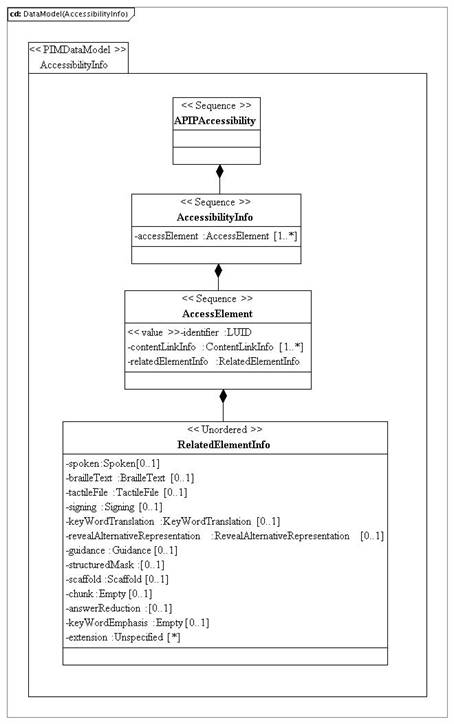
Figure 3.7 AccessibilityInfo class.
Table 3.77 The ‘AccessibilityInfo’ class.
|
Descriptor |
Definition |
|---|---|
|
Class name |
AccessibilityInfo |
|
Class type |
Container (Sequence) |
|
Parents |
APIPAccessibility |
|
Children |
[ accessElement ] |
|
Description |
This is the container for all of the information about the alternative accessibility content. |
3.7.1 ‘AccessElement’ Attribute Description
Table 3.78 The ‘accessElement’ attribute for the AccessibilityInfo class.
|
Descriptor |
Definition |
|---|---|
|
Attribute name |
accessElement |
|
Data type |
AccessElement |
|
Value space |
Container |
|
Multiplicity |
[1.. unbounded] |
|
Description |
The accessibility information consists of a list of ‘AccessElement’ structures. Each ‘AccessElement’ describes the nature of one alternative accessibility form. |
3.7.2 ‘AccessElement’ Class Description
The PIM for the AccessElement class is shown in Figure 3.7.
Table 3.79 The ‘AccessElement’ class.
|
Descriptor |
Definition |
|---|---|
|
Class name |
AccessElement |
|
Class type |
Container (Sequence) |
|
Parents |
AccessibilityInfo |
|
Children |
[ identifier, contentLinkInfo, relatedElementInfo ], ordered |
|
Description |
This is the container for the information about a single access element. |
3.7.2.1 ‘Identifier’ Attribute Description
Table 3.80 The ‘identifier’ attribute for the AccessElement class.
|
Descriptor |
Definition |
|---|---|
|
Attribute name |
identifier |
|
Data type |
LUID |
|
Value space |
See Appendix A. |
|
Multiplicity |
[1] |
|
Description |
This is the locally unique identifier for the access element. This is the identifier referenced by the ‘InclusionOrder’ structure. |
3.7.2.2 ‘ContentLinkInfo’ Attribute Description
Table 3.81 The ‘contentLinkInfo’ attribute for the AccessElement class.
|
Descriptor |
Definition |
|---|---|
|
Attribute name |
contentLinkInfo |
|
Data type |
ContentLinkInfo |
|
Value space |
Container |
|
Multiplicity |
[1..unbounded], unordered |
|
Description |
This is the pointer to the information that describes the relationships between the new alternative accessibility content and the original QTI content. An access element may also point to another access element i.e. recursive alternative content structures are possible. |
3.7.2.3 ‘RelatedElementInfo’ Attribute Description
Table 3.82 The ‘relatedElementInfo’ attribute for the AccessElement class.
|
Descriptor |
Definition |
|---|---|
|
Attribute name |
relatedElementInfo |
|
Data type |
RelatedElementInfo |
|
Value space |
Container |
|
Multiplicity |
[1] |
|
Description |
This is the link to the set of alternative accessibility content definitions for associated access element. |
3.7.3 ‘ContentLinkInfo’ Class Description
The PIM for the ContentLinkInfo class is shown in Figure 3.8.
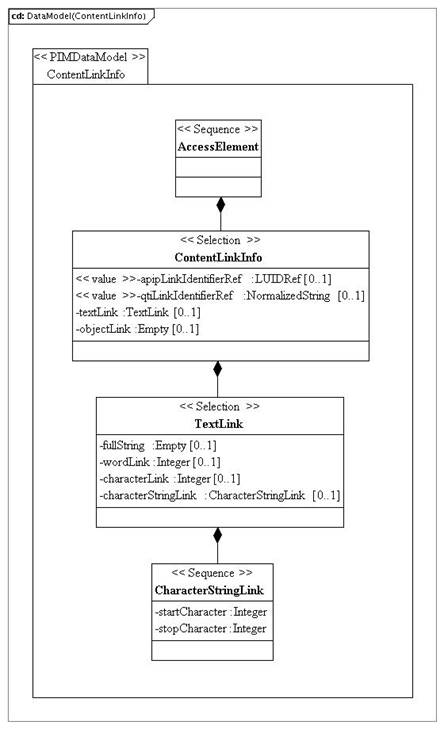
Figure 3.8 ContentLinkInfo class.
Table 3.83 The ‘ContentLinkInfo’ class.
|
Descriptor |
Definition |
|---|---|
|
Class name |
ContentLinkInfo |
|
Class type |
Container (Selection) |
|
Parents |
AccessElement |
|
Children |
[ apipLinkIdentifierRef, qtiIdentifierRef ], unordered |
|
Description |
This is the container for the information that describes how the new alternative accessibility content is linked to either the QTI content and/or another alternative accessibility content features plus either a text feature or an object feature. |
3.7.3.1 ‘ApipLinkIdentifierRef’ Attribute Description
Table 3.84 The ‘apipLinkIdentifierRef’ attribute for the ContentLinkInfo class.
|
Descriptor |
Definition |
|---|---|
|
Attribute name |
apipLinkIdentifierRef |
|
Data type |
LUIDRef |
|
Value space |
See Appendix A. |
|
Multiplicity |
[1] |
|
Description |
This is the pointer to other alternative accessibility content that has been defined in an access element definition. |
3.7.3.2 ‘QtiLinkIdentifierRef’ Attribute Description
Table 3.85 The ‘qtiLinkIdentifierRef’ attribute for the ContentLinkInfo class.
|
Descriptor |
Definition |
|---|---|
|
Attribute name |
qtiLinkIdentifierRef |
|
Data type |
NormalizedString |
|
Value space |
Normalized string. |
|
Multiplicity |
[0..1] |
|
Description |
This is the pointer to a feature within the QTI content described in the same instance file. The associated QTI structured is expected to have an ‘id’ attribute to which the value of the ‘qtiLinkIdentifierRef’ refers. |
3.7.3.3 ‘textLink’ Attribute Description
Table 3.86 The ‘textLink’ attribute for the ContentLinkInfo class.
|
Descriptor |
Definition |
|---|---|
|
Attribute name |
textLink |
|
Data type |
TextLink |
|
Value space |
Container |
|
Multiplicity |
[0..1] |
|
Description |
The pointer to the text structure description to which the content link refers. |
3.7.3.4 ‘ObjectLink’ Attribute Description
Table 3.87 The ‘objectLink’ attribute for the ContentLinkInfo class.
|
Descriptor |
Definition |
|---|---|
|
Attribute name |
objectLink |
|
Data type |
Empty |
|
Value space |
N/A |
|
Multiplicity |
[0..1] |
|
Description |
The pointer to the object structure to which the content links refers i.e. anything else other than a text string. The use of this pointer shows that the associated access element content is to be applied to the whole structure identified by the content link. |
3.7.4 ‘TextLink’ Class Description
The PIM for the TextLink class is shown in Figure 3.8.
Table 3.88 The ‘TextLink’ class.
|
Descriptor |
Definition |
|---|---|
|
Class name |
TextLink |
|
Class type |
Container (Selection) |
|
Parents |
ContentLinkInfo |
|
Children |
[ fullString, wordLink, characterLink, characterStringLink ], selection |
|
Description |
The container for the information that describes to which part of a text string the alternative accessibility content is to be applied. |
3.7.4.1 ‘FullString’ Attribute Description
Table 3.89 The ‘fullString’ attribute for the TextLink class.
|
Descriptor |
Definition |
|---|---|
|
Attribute name |
fullString |
|
Data type |
Empty |
|
Value space |
N/A |
|
Multiplicity |
[0..1] |
|
Description |
This is used to show that the accessibility content is an alternative to the full text string. |
3.7.4.2 ‘WordLink’ Attribute Description
Table 3.90 The ‘wordLink’ attribute for the TextLink class.
|
Descriptor |
Definition |
|---|---|
|
Attribute name |
wordLink |
|
Data type |
Integer |
|
Value space |
Integer [1 ≤ wordLink ≤ 9999] |
|
Multiplicity |
[0..1] |
|
Description |
This is used to show that the accessibility content is an alternative to a particular word in the text string. A word is any set of characters delineated by spaces, tabs and punctuation marks. |
3.7.4.3 ‘CharacterLink’ Attribute Description
Table 3.91 The ‘characterLink’ attribute for the TextLink class.
|
Descriptor |
Definition |
|---|---|
|
Attribute name |
characterLink |
|
Data type |
Integer |
|
Value space |
Integer [1 ≤ characterLink ≤ 9999] |
|
Multiplicity |
[0..1] |
|
Description |
This is used to show that the accessibility content is an alternative to a particular character (this include all spaces, tabs, punctuation marks etc.). |
3.7.4.4 ‘CharacterStringLink’ Attribute Description
Table 3.92 The ‘characterStringLink’ attribute for the TextLink class.
|
Descriptor |
Definition |
|---|---|
|
Attribute name |
characterStringLink |
|
Data type |
CharacterStringLink |
|
Value space |
Container |
|
Multiplicity |
[0..1] |
|
Description |
This is used to show that the accessibility content is an alternative to a substring. |
3.7.5 ‘CharacterStringLink’ Class Description
The PIM for the CharacterStringLink class is shown in Figure 3.8.
Table 3.93 The ‘CharacterStringLink’ class.
|
Descriptor |
Definition |
|---|---|
|
Class name |
CharacterStringLink |
|
Class type |
Container (Sequence) |
|
Parents |
TextLink |
|
Children |
[ startCharacter, stopCharacter ], ordered |
|
Description |
This is the container for the information that defines the substring to which the alternative accessibility content refers. This should not be used to identify strings of only one character length. |
3.7.5.1 ‘StartCharacter’ Attribute Description
Table 3.94 The ‘startCharacter’ attribute for the CharacterStringLink class.
|
Descriptor |
Definition |
|---|---|
|
Attribute name |
startCharacter |
|
Data type |
Integer |
|
Value space |
Integer [1 ≤ startCharacter ≤ 9999] and startCharacter < stopCharacter |
|
Multiplicity |
[1] |
|
Description |
The start character for the substring (this includes specs, tabs, punctuation marks, etc.). |
3.7.5.2 ‘StopCharacter’ Attribute Description
Table 3.95 The ‘stopCharacter’ attribute for the CharacterStringLink class.
|
Descriptor |
Definition |
|---|---|
|
Attribute name |
stopCharacter |
|
Data type |
Integer |
|
Value space |
Integer [1 ≤ stopCharacter ≤ 9999] and stopCharacter > startCharacter |
|
Multiplicity |
[1] |
|
Description |
The end character for the substring (this includes specs, tabs, punctuation marks, etc.). |
3.7.6 ‘RelatedElementInfo’ Class Description
The PIM for the RelatedElementInfo class is shown in Figure 3.7.
Table 3.96 The ‘RelatedElementInfo’ class.
|
Descriptor |
Definition |
|---|---|
|
Class name |
RelatedElementInfo |
|
Class type |
Container (Unordered) |
|
Parents |
AccessElement |
|
Children |
[ spoken, brailleText, tactileFile, signing, keyWordTranslation, revealAlternativeRepresentation, guidance, structuredMask, scaffold, chunk, answerReduction, keyWordEmphasis, extension ], unordered |
|
Description |
This is the container for the set of descriptions for the various types of alternative accessibility content. |
3.7.6.1 ‘Spoken’ Attribute Description
Table 3.97 The ‘spoken’ attribute for the RelatedElementInfo class.
|
Descriptor |
Definition |
|---|---|
|
Attribute name |
spoken |
|
Data type |
Spoken |
|
Value space |
Container |
|
Multiplicity |
[0..1] |
|
Description |
The container for alternative accessibility content that is to be rendered using spoken formats. |
3.7.6.2 ‘BrailleText’ Attribute Description
Table 3.98 The ‘brailleText’ attribute for the RelatedElementInfo class.
|
Descriptor |
Definition |
|---|---|
|
Attribute name |
brailleText |
|
Data type |
BrailleText |
|
Value space |
Container |
|
Multiplicity |
[0..1] |
|
Description |
The container for alternative accessibility content that is to be rendered using Braille text formats. |
3.7.6.3 ‘TactileFile’ Attribute Description
Table 3.99 The ‘tactileFile’ attribute for the RelatedElementInfo class.
|
Descriptor |
Definition |
|---|---|
|
Attribute name |
tactileFile |
|
Data type |
TactileFile |
|
Value space |
Container |
|
Multiplicity |
[0..1] |
|
Description |
The container for alternative accessibility content that is to be rendered using tactile formats. |
3.7.6.4 ‘Signing’ Attribute Description
Table 3.100 The ‘signing’ attribute for the RelatedElementInfo class.
|
Descriptor |
Definition |
|---|---|
|
Attribute name |
signing |
|
Data type |
Signing |
|
Value space |
Container |
|
Multiplicity |
[0..1] |
|
Description |
The container for alternative accessibility content that is to be rendered using signing formats. |
3.7.6.5 ‘keyWordTranslation’ Attribute Description
Table 3.101 The ‘keyWordTranslation’ attribute for the RelatedElementInfo class.
|
Descriptor |
Definition |
|---|---|
|
Attribute name |
keyWordTranslation |
|
Data type |
KeyWordTranslation |
|
Value space |
Container |
|
Multiplicity |
[0..1] |
|
Description |
The container for alternative accessibility content that is to be rendered using keyword translation formats. |
3.7.6.6 ‘RevealAlternativeRepresentation’ Attribute Description
Table 3.102 The ‘revealAlternativeRepresentation’ attribute for the RelatedElementInfo class.
|
Descriptor |
Definition |
|---|---|
|
Attribute name |
revealAlternativeRepresentation |
|
Data type |
RevealAlternativeRepresentation |
|
Value space |
Container |
|
Multiplicity |
[0..1] |
|
Description |
The container for alternative accessibility content that is to be rendered using a set of defined file formats. |
3.7.6.7 ‘Guidance’ Attribute Description
Table 3.103 The ‘guidance’ attribute for the RelatedElementInfo class.
|
Descriptor |
Definition |
|---|---|
|
Attribute name |
guidance |
|
Data type |
Guidance |
|
Value space |
Container |
|
Multiplicity |
[0..1] |
|
Description |
The container for alternative accessibility content that is to be rendered when guidance is enabled. |
3.7.6.8 ‘StructuredMask’ Attribute Description
Table 3.104 The ‘structuredMask’ attribute for the RelatedElementInfo class.
|
Descriptor |
Definition |
|---|---|
|
Attribute name |
structuredMask |
|
Data type |
StructuredMask |
|
Value space |
Container |
|
Multiplicity |
[0..1] |
|
Description |
The container for alternative accessibility content that is to be rendered when masking is enabled. |
3.7.6.9 ‘Scaffold’ Attribute Description
Table 3.105 The ‘scaffold’ attribute for the RelatedElementInfo class.
|
Descriptor |
Definition |
|---|---|
|
Attribute name |
scaffold |
|
Data type |
Scaffold |
|
Value space |
Container |
|
Multiplicity |
[0..1] |
|
Description |
The container for alternative accessibility content that is to be rendered when scaffolding is enabled. |
3.7.6.10 ‘Chunk’ Attribute Description
Table 3.106 The ‘chunk’ attribute for the RelatedElementInfo class.
|
Descriptor |
Definition |
|---|---|
|
Attribute name |
chunk |
|
Data type |
Empty. |
|
Value space |
N/A |
|
Multiplicity |
[0..1] |
|
Description |
The alternative accessibility content that is to be rendered when chunking is enabled. |
3.7.6.11 ‘AnswerReduction’ Attribute Description
Table 3.107 The ‘answerReduction’ attribute for the RelatedElementInfo class.
|
Descriptor |
Definition |
|---|---|
|
Attribute name |
answerReduction |
|
Data type |
AnswerReduction |
|
Value space |
Container |
|
Multiplicity |
[0..1] |
|
Description |
The container for alternative accessibility content that is to be rendered when answer reduction is enabled. |
3.7.6.12 ‘KeyWordEmphasis’ Attribute Description
Table 3.108 The ‘keyWordEmphasis’ attribute for the RelatedElementInfo class.
|
Descriptor |
Definition |
|---|---|
|
Attribute name |
keyWordEmphasis |
|
Data type |
Empty |
|
Value space |
N/A |
|
Multiplicity |
[0..1] |
|
Description |
The alternative accessibility content that is to be rendered when highlighting is enabled. |
3.7.6.13 ‘Extension’ Attribute Description
Table 3.109 The ‘extension’ attribute for the RelatedElementInfo class.
|
Descriptor |
Definition |
|---|---|
|
Attribute name |
extension |
|
Data type |
Unspecified |
|
Value space |
Defined in terms of how the Information Model is realised by a binding. |
|
Multiplicity |
[0..unbounded], unordered |
|
Description |
This is a placeholder. It informs bindings of this Information Model as to the valid locations that extend the parent class. The form of the extension is dependent on the binding. |
3.7.7 ‘Spoken’ Class Description
The PIM for the Spoken class is shown in Figure 3.9.
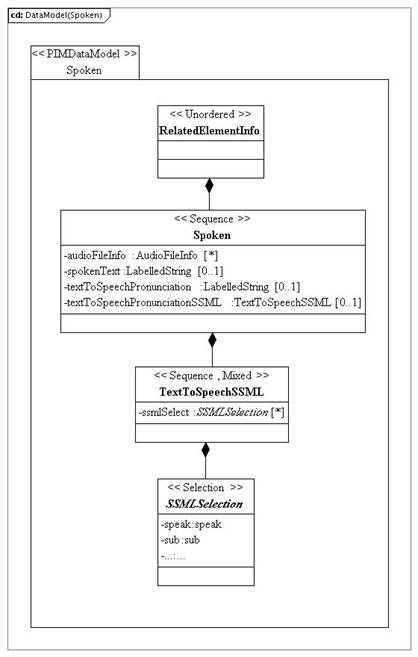
Figure 3.9 Spoken class.
Table 3.110 The ‘Spoken’ class.
|
Descriptor |
Definition |
|---|---|
|
Class name |
Spoken |
|
Class type |
Container (Sequence) |
|
Parents |
RelatedElementInfo |
|
Children |
[ audioFileInfo, spokenText, textToSpeechPronunication, textToSpeechPronunciationSSML ], ordered |
|
Description |
The container for the alternative accessibility content that is to be rendered using spoken formats. Audio presentation of narrative text, graphic, or other content element can be provided in two ways. For the first method, an audio file can be assigned to an element and the audio file can be played by the test delivery system. A separate audio file may be created for each content element or a portion of an audio file may be assigned to a content element. For the second method, a text-to-speech tool may be used to present an audio representation of the element. Standard text-to-speech read aloud requires the item writer to specify the text that is to be presented by the text-to-speech tool. Use of Speech Synthesis Markup Language is also supported as an alternative. |
3.7.7.1 ‘AudioFileInfo’ Attribute Description
Table 3.111 The ‘audioFileInfo’ attribute for the Spoken class.
|
Descriptor |
Definition |
|---|---|
|
Attribute name |
audioFileInfo |
|
Data type |
AudioFileInfo |
|
Value space |
Container |
|
Multiplicity |
[0..*] |
|
Description |
This points to the audio file that is to be played for the spoken format rendering. |
3.7.7.2 ‘SpokenText’ Attribute Description
Table 3.112 The ‘spokenText’ attribute for the Spoken class.
|
Descriptor |
Definition |
|---|---|
|
Attribute name |
spokenText |
|
Data type |
LabelledString |
|
Value space |
Container |
|
Multiplicity |
[0..1] |
|
Description |
This is the text string that is to be converted to the equivalent audio format using a text-to-speech tool. |
3.7.7.3 ‘TextToSpeechPronunciation’ Attribute Description
Table 3.113 The ‘textToSpeechPronunciation’ attribute for the Spoken class.
|
Descriptor |
Definition |
|---|---|
|
Attribute name |
textToSpeechPronunciation |
|
Data type |
LabelledString |
|
Value space |
Container |
|
Multiplicity |
[0..1] |
|
Description |
This is the text string that is to be converted to the equivalent audio format using a text-to-speech tool. The text is structured to provide explicit pronunciation guidance. |
3.7.7.4 ‘TextToSpeechPronunciationSSML’ Attribute Description
Table 3.114 The ‘textToSpeechPronunciationSSML’ attribute for the Spoken class.
|
Descriptor |
Definition |
|---|---|
|
Attribute name |
textToSpeechPronunciationSSML |
|
Data type |
TextToSpeechSSML |
|
Value space |
Container |
|
Multiplicity |
[0..1] |
|
Description |
The Speech Synthesis Markup Language (SSML) is designed to provide a rich, XML-based markup language for assisting the generation of synthetic speech in Web and other applications. The essential role of SSML is to provide authors of synthesizable textual content a standard way to control aspects of speech such as pronunciation, volume, pitch, rate, etc. across different synthesis-capable platforms that implement SSML. This provides another way to supply the text to speech pronunciation information. |
3.7.8 ‘TextToSpeechSSML’ Class Description
The PIM for the TextToSpeechSSML class is shown in Figure 3.9.
Table 3.115 The ‘TextToSpeechSSML’ class.
|
Descriptor |
Definition |
|---|---|
|
Class name |
TextToSpeechSSML |
|
Class type |
Container (Sequence, Mixed) |
|
Parents |
Spoken |
|
Children |
The set of elements that can be used at the top level from the SSML Recommendation from the W3C [SSML, 2011]. |
|
Description |
This is the container for the interleaved string and the associated SSML that is to be applied to the string. Note that the form of binding must ensure that there are no name clashes between the set of objects from the SSML and the host APIP/QTI objects. |
3.7.9 ‘BrailleText’ Class Description
The PIM for the BrailleText class is shown in Figure 3.10.
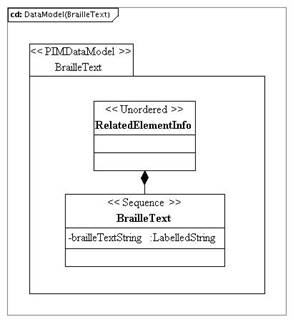
Figure 3.10 BrailleText class.
Table 3.116 The ‘BrailleText’ class.
|
Descriptor |
Definition |
|---|---|
|
Class name |
BrailleText |
|
Class type |
Container (Sequence) |
|
Parents |
RelatedElementInfo |
|
Children |
[ brailleTextString ] |
|
Description |
The container for the alternative accessibility content that is to be rendered using Braille text formats. Output to a refreshable Braille display presents the test taker with a Braille representation of text-based content. Braille display requires the item writer to define elements to which a Braille representation is assigned. |
3.7.9.1 ‘BrailleTextString’ Attribute Description
Table 3.117 The ‘brailleTextString’ attribute for the BrailleText class.
|
Descriptor |
Definition |
|---|---|
|
Attribute name |
brailleTextString |
|
Data type |
LabelledString |
|
Value space |
Container |
|
Multiplicity |
[1] |
|
Description |
The text string that is to be rendered in Braille. Each text block is also assigned a tab order in the non-visual inclusion order. The Braille display launches automatically when the test taker first encounters an item and transfers the Braille representation for the first element to the refreshable Braille display. The test taker may tab/navigate through the content and have the associated Braille representations transferred to the refreshable Braille display. |
3.7.10 ‘TactileFile’ Class Description
The PIM for the TactileFile class is shown in Figure 3.11.
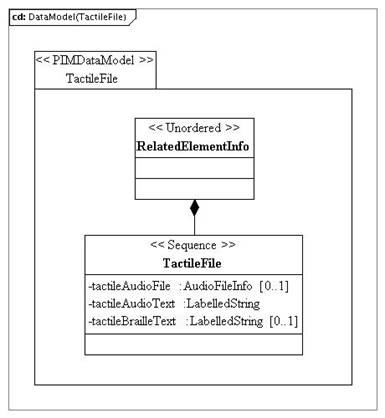
Figure 3.11 TactileFile class.
Table 3.118 The ‘TactileFile’ class.
|
Descriptor |
Definition |
|---|---|
|
Class name |
TactileFile |
|
Class type |
Container (Sequence) |
|
Parents |
RelatedElememtInfo |
|
Children |
[ tactileAudioFile, tactileAudioText, tactileBrailleText ], ordered |
|
Description |
The container for the alternative accessibility content to be rendered using tactile formats. For some graphic content, a tactile representation provides better access for some students than does an audio or Braille description. When a hard copy tactile representation is employed to provide access to graphic content, the ‘tactileFile’ description indicates to the test delivery system that a tactile representation is available. To alert the test taker that a tactile representation is available, the test delivery system will present an audio cue that refers to the associated hard copy tactile representation. |
3.7.10.1 ‘TactileAudioFile’ Attribute Description
Table 3.119 The ‘tactileAudioFile’ attribute for the TactileFile class.
|
Descriptor |
Definition |
|---|---|
|
Attribute name |
tactileAudioFile |
|
Data type |
AudioFileInfo |
|
Value space |
Container |
|
Multiplicity |
[0..1] |
|
Description |
The pointer to the audio file that is associated with the tactile description. Depending on the student access profile, the test delivery system may also provide a description of the tactile representation in audio form. |
3.7.10.2 ‘TactileAudioText’ Attribute Description
Table 3.120 The ‘tactileAudioText’ attribute for the TactileFile class.
|
Descriptor |
Definition |
|---|---|
|
Attribute name |
tactileAudioText |
|
Data type |
LabelledString |
|
Value space |
Container |
|
Multiplicity |
[1] |
|
Description |
This is a text string description equivalent of the information that is to be presented in the tactile file. This can be rendered using a text-to-speech tool. |
3.7.10.3 ‘TactileBrailleText’ Attribute Description
Table 3.121 The ‘tactileBrailleText’ attribute for the TactileFile class.
|
Descriptor |
Definition |
|---|---|
|
Attribute name |
tactileBrailleText |
|
Data type |
LabelledString |
|
Value space |
Container |
|
Multiplicity |
[0..1] |
|
Description |
This is a Braille text string description equivalent of the information that is to be presented in the tactile file. This can be rendered using a Braille display. |
3.7.11 ‘Signing’ Class Description
The PIM for the Signing class is shown in Figure 3.12.
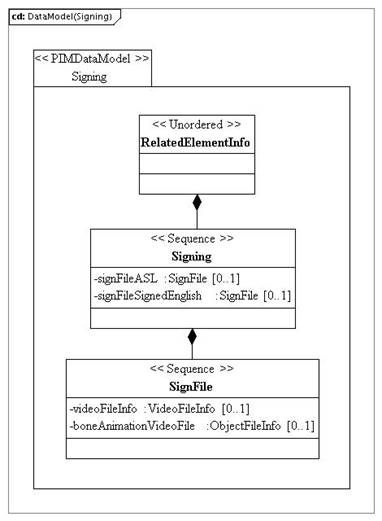
Figure 3.12 Signing class.
Table 3.122 The ‘Signing’ class.
|
Descriptor |
Definition |
|---|---|
|
Class name |
Signing |
|
Class type |
Container (Sequence) |
|
Parents |
RelatedElementInfo |
|
Children |
[ signFileASL, signFileSignedEnglish ], ordered |
|
Description |
The container for the alternative accessibility content to be rendered using sign language formats. For students who communicate in sign, access to item content may require the content to be presented in either American Sign Language or in another signed English representation. A signed presentation may be assigned to any accessibility element. |
3.7.11.1 ‘SignFileASL’ Attribute Description
Table 3.123 The ‘signFileASL’ attribute for the Signing class.
|
Descriptor |
Definition |
|---|---|
|
Attribute name |
signFileASL |
|
Data type |
SignFileASL |
|
Value space |
Container |
|
Multiplicity |
[0..1] |
|
Description |
For the information about the ASL based signing. |
3.7.11.2 ‘SignFileSignedEnglish’ Attribute Description
Table 3.124 The ‘signFileSignedEnglish’ attribute for the Signing class.
|
Descriptor |
Definition |
|---|---|
|
Attribute name |
signFileSignedEnglish |
|
Data type |
SignFileSignedEnglish |
|
Value space |
Container |
|
Multiplicity |
[0..1] |
|
Description |
For the information about the Signed English based signing. |
3.7.12 ‘SignFile’ Class Description
The PIM for the SignFile class is shown in Figure 3.12.
Table 3.125 The ‘SignFile’ class.
|
Descriptor |
Definition |
|---|---|
|
Class name |
SignFile |
|
Class type |
Container (Sequence) |
|
Parents |
Signing |
|
Children |
[ videoFileInfo, boneAnimationVideoFile ], ordered |
|
Description |
The container for the alternative accessibility content to be rendered using sign language formats. The signing can be supplied as video and bone animation files. |
3.7.12.1 ‘VideoFileInfo’ Attribute Description
Table 3.126 The ‘videoFileInfo’ attribute for the SignFile class.
|
Descriptor |
Definition |
|---|---|
|
Attribute name |
videoFileInfo |
|
Data type |
VideoFileInfo |
|
Value space |
Container |
|
Multiplicity |
[0..1] |
|
Description |
This is the pointer to the video file that contains the associate signing. A separate video file or a portion of a video file may be assigned to each accessibility element. |
3.7.12.2 ‘BoneAnimationVideoFileInfo’ Attribute Description
Table 3.127 The ‘boneAnimationVideoFileInfo’ attribute for the SignFile class.
|
Descriptor |
Definition |
|---|---|
|
Attribute name |
boneAnimationVideoFileInfo |
|
Data type |
ObectFileInfo |
|
Value space |
Container |
|
Multiplicity |
[0..1] |
|
Description |
This is the pointer to the bone animation video file that contains the associate signing. Bone animation scripts allow a bone animation player to present an animated representation of signed presentation of the accessibility element. Bone animation players render video images using an avatar. Alternatively, a pre-recorded video file may be used to present a signed representation of the accessibility |
3.7.13 ‘KeyWordTranslation’ Class Description
The PIM for the KeyWordTranslation class is shown in Figure 3.13.
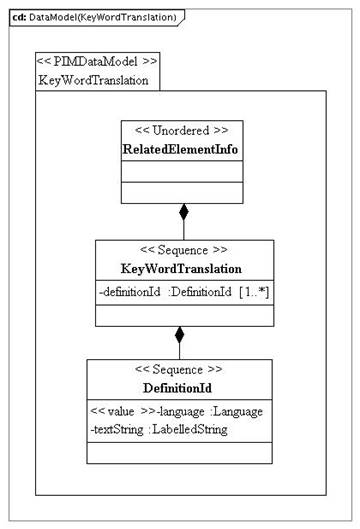
Figure 3.13 KeyWordTranslation class.
Table 3.128 The ‘KeyWordTranslation’ class.
|
Descriptor |
Definition |
|---|---|
|
Class name |
KeyWordTranslation |
|
Class type |
Container (Sequence) |
|
Parents |
RelatedElementInfo |
|
Children |
[ definitionId ], unordered |
|
Description |
The container for the alternative accessibility content to be rendered using keyword translation formats. A test taker for whom the default language used to represent item content is different than the test taker’s native language may require specific key words to be translated to another language. This attribute indicates that a translated representation of the associated accessibility element should be provided to test takers whose Examine Accessibility Information profile specifies key word translation. |
3.7.13.1 ‘DefinitionId’ Attribute Description
Table 3.129 The ‘definitionId’ attribute for the KeyWordTranslation class.
|
Descriptor |
Definition |
|---|---|
|
Attribute name |
definitionId |
|
Data type |
DefinitionId |
|
Value space |
Container |
|
Multiplicity |
[1..unbounded] |
|
Description |
When a key word translation is accessed by the test taker, the ‘definitionId’ is used to determine the proper definition of the key word that is to be translated. The ‘definitionId’ is then used to locate the associated translation of the word and to present that translation in text-based form. |
3.7.14 ‘DefinitionId’ Class Description
The PIM for the DefinitionId class is shown in Figure 3.13.
Table 3.130 The ‘DefinitionId’ class.
|
Descriptor |
Definition |
|---|---|
|
Class name |
DefinitionId |
|
Class type |
Container (Sequence) |
|
Parents |
KeyWordTranslation |
|
Children |
[ language, textString ], ordered |
|
Description |
The container for the information to be used to achieve keyword translation. |
3.7.14.1 ‘Language’ Attribute Description
Table 3.131 The ‘language’ attribute for the DefinitionId class.
|
Descriptor |
Definition |
|---|---|
|
Attribute name |
language |
|
Data type |
Language |
|
Value space |
See Appendix A. |
|
Multiplicity |
[1] |
|
Description |
This is the language for the keyword translation. |
3.7.14.2 ‘TextString’ Attribute Description
Table 3.132 The ‘textString’ attribute for the DefinitionId class.
|
Descriptor |
Definition |
|---|---|
|
Attribute name |
textString |
|
Data type |
LabelledString |
|
Value space |
Container |
|
Multiplicity |
[1] |
|
Description |
The translated text string for the keyword. |
3.7.15 ‘RevealAlternativeRepresentation’ Class Description
The PIM for the RevealAlternativeRepresentation class is shown in Figure 3.14.

Figure 3.14 RevealAlternativeRepresentation class.
Table 3.133 The ‘RevealAlternativeRepresentation’ class.
|
Descriptor |
Definition |
|---|---|
|
Class name |
RevealAlternativeRepresentation |
|
Class type |
Container (Selection) |
|
Parents |
[ RelatedElementInfo ] |
|
Children |
[ audioFileInfo, videoFileInfo, graphicFileInfo, textFileInfo, textString, markupFileInfo, markupFileEmbedded, executableFileInfo, extensions ], selected |
|
Description |
The container for the alternative accessibility content to be rendered using various alternative formats. It allows a student to access to an alternate representation for a specific object contained in an item. As a few examples, a bar chart may be substituted for a table presenting frequency counts, an animation may be substituted for a figure depicting a life cycle, or narrative text may be substituted for information presented in figure or chart. In all cases, this provides to the test delivery system the filename that contains an alternate representation for a given object that is then displayed as supplemental information for the test taker. The alternate representation is displayed on-demand by the student. |
3.7.15.1 ‘AudioFileInfo’ Attribute Description
Table 3.134 The ‘audioFileInfo’ attribute for the RevealAlternativeRepresentation class.
|
Descriptor |
Definition |
|---|---|
|
Attribute name |
audioFileInfo |
|
Data type |
AudioFileInfo |
|
Value space |
Container |
|
Multiplicity |
[0..1] |
|
Description |
The pointer to the audio file that can be used as the rendering of the alternative representation. |
3.7.15.2 ‘VideoFileInfo’ Attribute Description
Table 3.135 The ‘videoFileInfo’ attribute for the RevealAlternativeRepresentation class.
|
Descriptor |
Definition |
|---|---|
|
Attribute name |
videoFileInfo |
|
Data type |
VideoFileInfo |
|
Value space |
Container |
|
Multiplicity |
[0..1] |
|
Description |
The pointer to the video file that can be used as the rendering of the alternative representation. |
3.7.15.3 ‘GraphicFileInfo’ Attribute Description
Table 3.136 The ‘graphicFileInfo’ attribute for the RevealAlternativeRepresentation class.
|
Descriptor |
Definition |
|---|---|
|
Attribute name |
graphicFileInfo |
|
Data type |
ObjectFileInfo |
|
Value space |
Container |
|
Multiplicity |
[0..1] |
|
Description |
The pointer to the image file that can be used as the rendering of the alternative representation. |
3.7.15.4 ‘textFileInfo’ Attribute Description
Table 3.137 The ‘textFileInfo’ attribute for the RevealAlternativeRepresentation class.
|
Descriptor |
Definition |
|---|---|
|
Attribute name |
textFileInfo |
|
Data type |
ObjectFileInfo |
|
Value space |
Container |
|
Multiplicity |
[0..1] |
|
Description |
The pointer to the text file that can be used as the rendering of the alternative representation. |
3.7.15.5 ‘textString’ Attribute Description
Table 3.138 The ‘textString’ attribute for the RevealAlternativeRepresentation class.
|
Descriptor |
Definition |
|---|---|
|
Attribute name |
textString |
|
Data type |
LabelledString |
|
Value space |
Container |
|
Multiplicity |
0..1 |
|
Description |
The pointer to the text string that can be used as the rendering of the alternative representation. |
3.7.15.6 ‘MarkupFileInfo’ Attribute Description
Table 3.139 The ‘markupFileInfo’ attribute for the RevealAlternativeRepresentation class.
|
Descriptor |
Definition |
|---|---|
|
Attribute name |
markupFileInfo |
|
Data type |
ObjectFileInfo |
|
Value space |
Container |
|
Multiplicity |
[0..1] |
|
Description |
The pointer to the external mark-up file that can be used as the rendering of the alternative representation. The form of mark-up is undefined i.e. it could be HTML, XML, etc. |
3.7.15.7 ‘MarkupFileEmbedded’ Attribute Description
Table 3.140 The ‘MarkupFileEmbedded’ attribute for the RevealAlternativeRepresentation class.
|
Descriptor |
Definition |
|---|---|
|
Attribute name |
markupFileEmbedded |
|
Data type |
MarkupFileEmbedded |
|
Value space |
Container |
|
Multiplicity |
[0..1] |
|
Description |
This is the pointer to the mark-up information that is embedded within the QTI instance file (this is expected to take the form of an XML namespace extension). |
3.7.15.8 ‘ExecutableFileInfo’ Attribute Description
Table 3.141 The ‘executableFileInfo’ attribute for the RevealAlternativeRepresentation class.
|
Descriptor |
Definition |
|---|---|
|
Attribute name |
executableFileInfo |
|
Data type |
ObjectFileInfo |
|
Value space |
Container |
|
Multiplicity |
[0..1] |
|
Description |
The pointer to the external flash file that can be used as the rendering of the alternative representation. |
3.7.15.9 ‘Extension’ Attribute Description
Table 3.142 The ‘extension’ attribute for the RevealAlternativeRepresentation class.
|
Descriptor |
Definition |
|---|---|
|
Attribute name |
extension |
|
Data type |
Unspecified |
|
Value space |
Defined in terms of how the Information Model is realised by a binding. |
|
Multiplicity |
[0..unbounded], unordered |
|
Description |
This is a placeholder. It informs bindings of this Information Model as to the valid locations that extend the parent class. The form of the extension is dependent on the binding. |
3.7.16 ‘MarkupFileEmbedded’ Class Description
The PIM for the MarkupFileEmbedded class is shown in Figure 3.14.
Table 3.143 The ‘MarkupFileEmbedded’ class.
|
Descriptor |
Definition |
|---|---|
|
Class name |
MarkupFileEmbedded |
|
Class type |
Container (Sequence) |
|
Parents |
RevealAlternativeRepresentation |
|
Children |
[ extensions ], ordered |
|
Description |
This is a placeholder for any embedded mark-up language e.g. HTML, etc. It informs bindings of this Information Model as to the valid locations that extend the parent class. |
3.7.16.1 ‘Extensions’ Attribute Description
Table 3.144 The ‘extension’ attribute for the MarkupFileEmbedded class.
|
Descriptor |
Definition |
|---|---|
|
Attribute name |
extensions |
|
Data type |
Unspecified |
|
Value space |
Defined in terms of how the Information Model is realised by a binding. |
|
Multiplicity |
[0..unbounded], unordered |
|
Description |
This is a placeholder. It informs bindings of this Information Model as to the valid locations that extend the parent class. The form of the extension is dependent on the binding. |
3.7.17 ‘Guidance’ Class Description
The PIM for the Guidance class is shown in Figure 3.15.
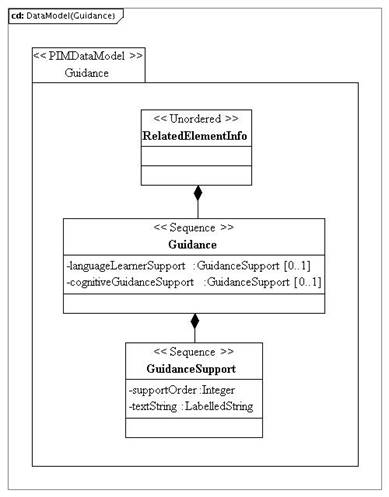
Figure 3.15 Guidance class.
Table 3.145 The ‘Guidance’ class.
|
Descriptor |
Definition |
|---|---|
|
Class name |
Guidance |
|
Class type |
Container (Sequence) |
|
Parents |
RelatedElementInfo |
|
Children |
[ langageLearnerSupport, cognitiveGuidanceSupport ], ordered |
|
Description |
This is the container for the instructions on how to render information that is subjected to guidance. This is used for students who require assistance identifying the key components of an item; guidance presents additional information or cues to the test taker. |
3.7.17.1 ‘LangageLearnerSupport’ Attribute Description
Table 3.146 The ‘langageLearnerSupport’ attribute for the Guidance class.
|
Descriptor |
Definition |
|---|---|
|
Attribute name |
langageLearnerSupport |
|
Data type |
GuidanceSupport |
|
Value space |
Container |
|
Multiplicity |
[0..1] |
|
Description |
Defines the nature of the guidance available for language learners. |
3.7.17.2 ‘CognitiveGuidanceSupport’ Attribute Description
Table 3.147 The ‘cognitveGuidanceSupport’ attribute for the Guidance class.
|
Descriptor |
Definition |
|---|---|
|
Attribute name |
cognitveGuidanceSupport |
|
Data type |
GuidanceSupport |
|
Value space |
Container |
|
Multiplicity |
[0..1] |
|
Description |
Defines the nature of the cognitive guidance available. |
3.7.18 ‘GuidanceSupport’ Class Description
The PIM for the GuidanceSupport class is shown in Figure 3.15.
Table 3.148 The ‘GuidanceSupport’ class.
|
Descriptor |
Definition |
|---|---|
|
Class name |
GuidanceSupport |
|
Class type |
Container (Sequence) |
|
Parents |
RelatedElementInfo |
|
Children |
[ supportOrder, textString ], ordered |
|
Description |
Guidance is applied to item content and specifies to the test delivery system both the additional information that is to be displayed for the test taker and the content with which the guidance is associated. When the item is presented on screen, the test delivery system may automatically display guidance associated with the item or may display guidance on-demand, depending on the specifications provided in the student access profile. |
3.7.18.1 ‘SupportOrder’ Attribute Description
Table 3.149 The ‘supportOrder’ attribute for the GuidanceSupport class.
|
Descriptor |
Definition |
|---|---|
|
Attribute name |
supportOrder |
|
Data type |
Integer |
|
Value space |
1 ≤ supportOrder ≤ 2047 |
|
Multiplicity |
[1] |
|
Description |
Defines the order for the associated guidance presentation. |
3.7.18.2 ‘TextString’ Attribute Description
Table 3.150 The ‘textString’ attribute for the GuidanceSupport class.
|
Descriptor |
Definition |
|---|---|
|
Attribute name |
textString |
|
Data type |
LabelledString |
|
Value space |
Container |
|
Multiplicity |
[1] |
|
Description |
This is the pointer to the text string that is available as a note associated with the guidance. |
3.7.19 ‘StructuredMask’ Class Description
The PIM for the StructuredMask class is shown in Figure 3.16.
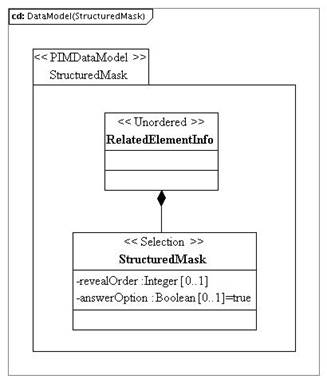
Figure 3.16 StructuredMask class.
Table 3.151 The ‘StructuredMask’ class.
|
Descriptor |
Definition |
|---|---|
|
Class name |
StructuredMask |
|
Class type |
Container (Selection) |
|
Parents |
RelatedElementInfo |
|
Children |
[ revealOrder, answerOption ], selected |
|
Description |
This is the container for the information about how a structured mask is to be applied to the content to be rendered. For students who require assistance maintaining focus, masking may be used to display smaller blocks of information. Structured masking is used to assist the student in developing an understanding of an item by masking specific elements of the item and revealing them in a prescribed order. A separate structured mask tag is applied to each item content structure and the order of revelation for each piece of content is specified for each mask. |
3.7.19.1 ‘RevealOrder’ Attribute Description
Table 3.152 The ‘revealOrder’ attribute for the StructuredMask class.
|
Descriptor |
Definition |
|---|---|
|
Attribute name |
revealOrder |
|
Data type |
Integer |
|
Value space |
1 ≤ revealOrder ≤ 2047 |
|
Multiplicity |
[0..1] |
|
Description |
The order of revelation for the associated masked object. |
3.7.19.2 ‘AnswerOption’ Attribute Description
Table 3.153 The ‘answerOption’ attribute for the StructuredMask class.
|
Descriptor |
Definition |
|---|---|
|
Attribute name |
answerOption |
|
Data type |
Boolean |
|
Value space |
Enumerated: { true | false }. Default = true. |
|
Multiplicity |
[1] |
|
Description |
Defines whether or not the answer option is to be masked. Answer options are included in structured mask by default, and should be ordered last. The value ‘true’ denotes that the answer options should be masked. |
3.7.20 ‘Scaffold’ Class Description
The PIM for the Scaffold class is shown in Figure 3.17.
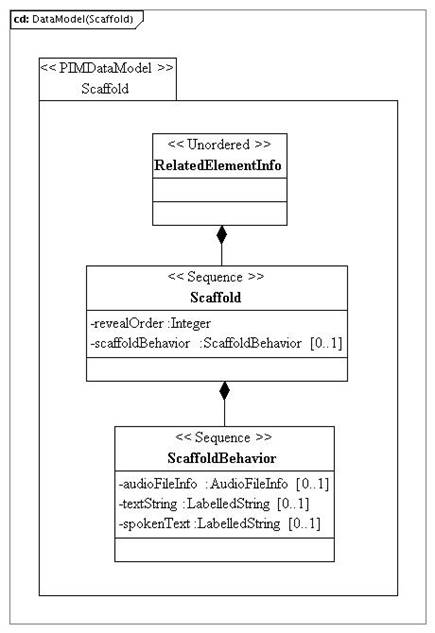
Figure 3.17 Scaffold class.
Table 3.154 The ‘Scaffold’ class.
|
Descriptor |
Definition |
|---|---|
|
Class name |
Scaffold |
|
Class type |
Container (Sequence) |
|
Parents |
RelatedElementInfo |
|
Children |
[ revealOrder, scaffoldBehavior ], ordered |
|
Description |
This is the container for the information that can have scaffolding used to support its rendering. For students who require a high level of support processing information presented in an item and who may require assistance maintaining focus, scaffolding is designed to walk a student through an item element by element with additional support provided. Scaffolding combines elements of flagging and masking. Like structured masking, scaffolding applies a mask to specific item content and specifies the order in which a mask is to be revealed. Like flagging, scaffolding associates additional information with item content. |
3.7.20.1 ‘RevealOrder’ Attribute Description
Table 3.155 The ‘revealOrder’ attribute for the Scaffold class.
|
Descriptor |
Definition |
|---|---|
|
Attribute name |
revealOrder |
|
Data type |
Integer |
|
Value space |
1 ≤ revealOrder ≤ 2047 |
|
Multiplicity |
[1] |
|
Description |
The order of revelation. |
3.7.20.2 ‘ScaffoldBehavior’ Attribute Description
Table 3.156 The ‘scaffoldBehavior’ attribute for the Scaffold class.
|
Descriptor |
Definition |
|---|---|
|
Attribute name |
scaffoldBehavior |
|
Data type |
ScaffoldBehavior |
|
Value space |
Container |
|
Multiplicity |
[0..1] |
|
Description |
This is the pointer to the information that describes the behavior of the scaffolding to be used to support the rendering of the alternative content. |
3.7.21 ‘ScaffoldBehavior’ Class Description
The PIM for the ScaffoldBehavior class is shown in Figure 3.17.
Table 3.157 The ‘ScaffoldBehavior’ class.
|
Descriptor |
Definition |
|---|---|
|
Class name |
ScaffoldBehavior |
|
Class type |
Container (Sequence) |
|
Parents |
Scaffold |
|
Children |
[ audioFileInfo, textString, spokenText ], ordered |
|
Description |
The container for the scaffolding behavior. |
3.7.21.1 ‘AudioFileInfo’ Attribute Description
Table 3.158 The ‘audioFileInfo’ attribute for the ScaffoldBehavior class.
|
Descriptor |
Definition |
|---|---|
|
Attribute name |
audioFileInfo |
|
Data type |
AudioFileInfo |
|
Value space |
Container |
|
Multiplicity |
[0..1] |
|
Description |
The pointer for the audio file that can be played as part of the scaffolding activity. |
3.7.21.2 ‘TextString’ Attribute Description
Table 3.159 The ‘textString’ attribute for the ScaffoldBehavior class.
|
Descriptor |
Definition |
|---|---|
|
Attribute name |
textString |
|
Data type |
LabelledString |
|
Value space |
Container |
|
Multiplicity |
[0..1] |
|
Description |
The text string that can be played as part of the scaffolding activity. |
3.7.21.3 ‘SpokenText’ Attribute Description
Table 3.160 The ‘spokenText’ attribute for the ScaffoldBehavior class.
|
Descriptor |
Definition |
|---|---|
|
Attribute name |
spokenText |
|
Data type |
LabelledString |
|
Value space |
Container |
|
Multiplicity |
[0..1] |
|
Description |
This is the text that is to be presented in audio format by a text-to-speech tool. |
3.7.22 ‘AnswerReduction’ Class Description
The PIM for the AnswerReduction class is shown in Figure 3.18.
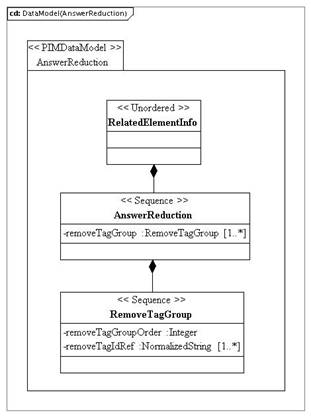
Figure 3.18 AnswerReduction class.
Table 3.161 The ‘AnswerReduction’ class.
|
Descriptor |
Definition |
|---|---|
|
Class name |
AnswerReduction |
|
Class type |
Container (Sequence) |
|
Parents |
RelatedElementInfo |
|
Children |
[ removeTagGroup ], unordered |
|
Description |
This is the container for the instructions on how to perform answer reduction. This reduces the number of answer options displayed for a forced choice item. Often, the answer option that is removed is the least discriminating option. When the Examine Accessibility Information profile specifies reduced answer options, the test delivery system will remove any answer option to which the remove option tag is applied. Only those options to which the remove option tag has NOT been applied will be displayed to the student |
3.7.22.1 ‘RemoveTagGroup’ Attribute Description
Table 3.162 The ‘removeTagGroup’ attribute for the AnswerReduction class.
|
Descriptor |
Definition |
|---|---|
|
Attribute name |
removeTagGroup |
|
Data type |
RemoveTagGroup |
|
Value space |
Container |
|
Multiplicity |
[1..unbounded], unordered |
|
Description |
The set of information about the group of remove tag instructions for the answer reduction activity. |
3.7.23 ‘RemoveTagGroup’ Class Description
The PIM for the RemoveTagGroup class is shown in Figure 3.18.
Table 3.163 The ‘RemoveTagGroup’ class.
|
Descriptor |
Definition |
|---|---|
|
Class name |
RemoveTagGroup |
|
Class type |
Container (Sequence) |
|
Parents |
AnswerReduction |
|
Children |
[ removeTagGroupOrder, removeTagIdRef ], ordered |
|
Description |
This is the container for a remove tag group. |
3.7.23.1 ‘RemoveTagGroupOrder’ Attribute Description
Table 3.164 The ‘removeTagGroupOrder’ attribute for the RemoveTagGroup class.
|
Descriptor |
Definition |
|---|---|
|
Attribute name |
removeTagGroupOrder |
|
Data type |
Integer |
|
Value space |
1 ≤ removeTagGroup ≤ 2047 |
|
Multiplicity |
[1] |
|
Description |
The order in which the removal should be applied. |
3.7.23.2 ‘RemoveTagIdRef’ Attribute Description
Table 3.165 The ‘removeTagIdRef’ attribute for the RemoveTagGroup class.
|
Descriptor |
Definition |
|---|---|
|
Attribute name |
removeTagIdRef |
|
Data type |
NormalizedString |
|
Value space |
Normalized string. |
|
Multiplicity |
[1..unbounded] |
|
Description |
The set of identifiers that are used to identify the objects to be removed. |
3.7.24 ‘LabelledString’ Class Description
The PIM for the LabelledString class is shown in Figure 3.19.
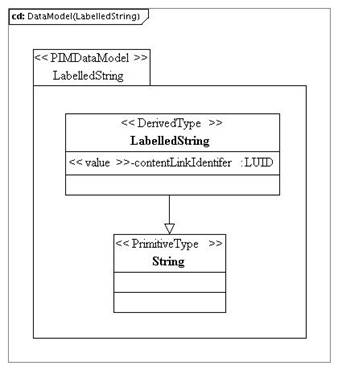
Figure 3.19 LabelledString class.
Table 3.166 The ‘LabelledString’ class.
|
Descriptor |
Definition |
|---|---|
|
Class name |
LabelledString |
|
Class type |
String |
|
Parents |
Various |
|
Children |
[ contentLinkIdentifier ] |
|
Description |
This is the container for a labelled string. This is a string that has an allocated content link identifier i.e. it can also have alternative accessibility content instructions assigned to it. |
3.7.24.1 ‘ContentLinkIdentifier’ Attribute Description
Table 3.167 The ‘contentLinkIdentifier’ attribute for the LabelledString class.
|
Descriptor |
Definition |
|---|---|
|
Attribute name |
contentLinkIdentifier |
|
Data type |
LUID |
|
Value space |
See Appendix A. |
|
Multiplicity |
[1] |
|
Description |
This is the locally unique identifier for the associated string. This is the identifier to be referenced by other alternative accessibility content structures. |
3.7.25 ‘AudioFileInfo’ Class Description
The PIM for the AudioFileInfo class is shown in Figure 3.20.
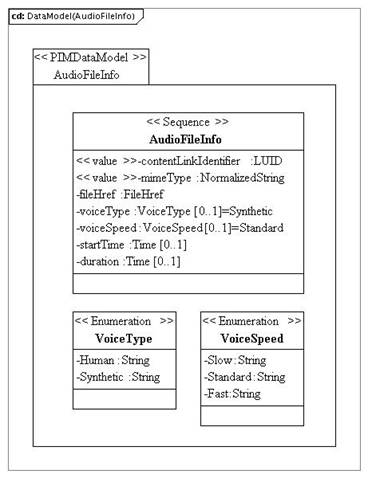
Figure 3.20 AudioFileInfo class.
Table 3.168 The ‘AudioFileInfo’ class.
|
Descriptor |
Definition |
|---|---|
|
Class name |
AudioFileInfo |
|
Class type |
Container (Sequence) |
|
Parents |
Various |
|
Children |
[ contentLinkIdentifier, mimeType, voiceType, voiceSpeed, fileHref, startTime, duration ], ordered |
|
Description |
This is the container for the formation about an audio file. |
3.7.25.1 ‘ContentLinkIdentifier’ Attribute Description
Table 3.169 The ‘contentLinkIdentifier’ attribute for the AudioFileInfo class.
|
Descriptor |
Definition |
|---|---|
|
Attribute name |
contentLinkIdentifier |
|
Data type |
LUID |
|
Value space |
See Appendix A. |
|
Multiplicity |
[1] |
|
Description |
This is the locally unique identifier for the associated audio file. This is the identifier to be referenced by other alternative accessibility content structures. |
3.7.25.2 ‘MimeType’ Attribute Description
Table 3.170 The ‘mimeType’ attribute for the AudioFileInfo class.
|
Descriptor |
Definition |
|---|---|
|
Attribute name |
mimeType |
|
Data type |
NormalizedString |
|
Value space |
See Appendix A. |
|
Multiplicity |
[1] |
|
Description |
This is the mime-type of the associated audio file. |
3.7.25.3 ‘FileHref’ Attribute Description
Table 3.171 The ‘fileHref’ attribute for the AudioFileInfo class.
|
Descriptor |
Definition |
|---|---|
|
Attribute name |
fileHref |
|
Data type |
FileHref |
|
Value space |
See Appendix A. |
|
Multiplicity |
[1] |
|
Description |
This is the link to the file itself. The form of the link depends upon the actual binding realisation. |
3.7.25.4 ‘VoiceType’ Attribute Description
Table 3.172 The ‘voiceType’ attribute for the AudioFileInfo class.
|
Descriptor |
Definition |
|---|---|
|
Attribute name |
voiceType |
|
Data type |
Enumerated |
|
Value space |
Enumeration of: { Human | Synthetic }. Default=Synthetic. |
|
Multiplicity |
[0..1] |
|
Description |
This is used to define the type of voice to be used to support the audioFile. |
3.7.25.5 ‘VoiceSpeed’ Attribute Description
Table 3.173 The ‘voiceSpeed’ attribute for the AudioFileInfo class.
|
Descriptor |
Definition |
|---|---|
|
Attribute name |
voiceSpeed |
|
Data type |
Enumerated |
|
Value space |
Enumeration of: { Slow | Standard | Fast }. Default=Standard. |
|
Multiplicity |
[0..1] |
|
Description |
This is used to define the speed of speech for the voice to be used to support the audioFile. |
3.7.25.6 ‘StartTime’ Attribute Description
Table 3.174 The ‘startTime’ attribute for the AudioFileInfo class.
|
Descriptor |
Definition |
|---|---|
|
Attribute name |
startTime |
|
Data type |
Time |
|
Value space |
See Appendix A. |
|
Multiplicity |
[0..1] |
|
Description |
This is the start point in the audio file that is to be used for the associated rendering (this allows a single audio file to be reused). If absent the start time is at the start of the file. |
3.7.25.7 ‘Duration’ Attribute Description
Table 3.175 The ‘duration’ attribute for the AudioFileInfo class.
|
Descriptor |
Definition |
|---|---|
|
Attribute name |
duration |
|
Data type |
Time |
|
Value space |
See Appendix A. |
|
Multiplicity |
[0..1] |
|
Description |
This is the duration of the audio clip that is to be presented. If absent the duration is the full length of the audio clip contained in the file. |
3.7.26 ‘VideoFileInfo’ Class Description
The PIM for the VideoFileInfo class is shown in Figure 3.21.

Figure 3.21 VideoFileInfo class.
Table 3.176 The ‘VideoFileInfo’ class.
|
Descriptor |
Definition |
|---|---|
|
Class name |
VideoFileName |
|
Class type |
Container (Sequence) |
|
Parents |
Various |
|
Children |
[ contentLinkIdentifier, mimeType, fileHref, startCue, stopCue ], ordered |
|
Description |
This is the container for the formation about a video file. |
3.7.26.1 ‘ContentLinkIdentifier’ Attribute Description
Table 3.177 The ‘contentLinkIdentifier’ attribute for the VideoFileInfo class.
|
Descriptor |
Definition |
|---|---|
|
Attribute name |
contentLinkIdentifier |
|
Data type |
LUID |
|
Value space |
See Appendix A. |
|
Multiplicity |
[1] |
|
Description |
This is the locally unique identifier for the associated video file. This is the identifier to be referenced by other alternative accessibility content structures. |
3.7.26.2 ‘MimeType’ Attribute Description
Table 3.178 The ‘mimeType’ attribute for the VideoFileInfo class.
|
Descriptor |
Definition |
|---|---|
|
Attribute name |
mimeType |
|
Data type |
NormalizedString |
|
Value space |
See Appendix A. |
|
Multiplicity |
[1] |
|
Description |
This is the mime-type of the associated video file. |
3.7.26.3 ‘FileHref’ Attribute Description
Table 3.179 The ‘fileHref’ attribute for the VideoFileInfo class.
|
Descriptor |
Definition |
|---|---|
|
Attribute name |
fileHref |
|
Data type |
FileHref |
|
Value space |
See Appendix A. |
|
Multiplicity |
[1] |
|
Description |
This is the link to the file itself. The form of the link depends upon the actual binding realisation. |
3.7.26.4 ‘StartCue’ Attribute Description
Table 3.180 The ‘startCue’ attribute for the VideoFileInfo class.
|
Descriptor |
Definition |
|---|---|
|
Attribute name |
startCue |
|
Data type |
Time |
|
Value space |
See Appendix A. |
|
Multiplicity |
[0..1] |
|
Description |
This is the start point in the video file that is to be used for the associated rendering (this allows a single video file to be reused). If absent the start time is at the start of the file. |
3.7.26.5 ‘EndCue’ Attribute Description
Table 3.181 The ‘endCue’ attribute for the VideoFileInfo class.
|
Descriptor |
Definition |
|---|---|
|
Attribute name |
endCue |
|
Data type |
Time |
|
Value space |
See Appendix A. |
|
Multiplicity |
[0..1] |
|
Description |
This is the end point in the video file that is to be used for the associated rendering (this allows a single video file to be reused). If absent the end time is at the end of the file. |
3.7.27 ‘ObjectFileInfo’ Class Description
The PIM for the ObjectFileInfo class is shown in Figure 3.22.
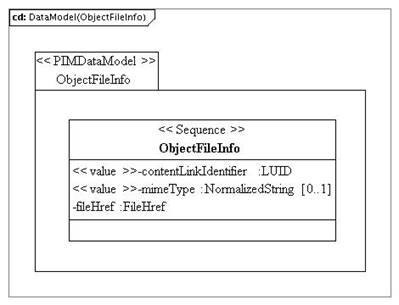
Figure 3.22 ObjectFileInfo class.
Table 3.182 The ‘ObjectFileInfo’ class.
|
Descriptor |
Definition |
|---|---|
|
Class name |
ObjectFleInfo |
|
Class type |
Container (Sequence) |
|
Parents |
Various |
|
Children |
[ contentLinkIdentifier, mimeType, fileHref ], ordered |
|
Description |
This is the container for the formation about the object file. |
3.7.27.1 ‘ContentLinkIdentifier’ Attribute Description
Table 3.183 The ‘contentLinkIdentifier’ attribute for the ObjectFileInfo class.
|
Descriptor |
Definition |
|---|---|
|
Attribute name |
contentLinkIdentifier |
|
Data type |
LUID |
|
Value space |
See Appendix A. |
|
Multiplicity |
[1] |
|
Description |
This is the locally unique identifier for the associated object file. This is the identifier to be referenced by other alternative accessibility content structures. |
3.7.27.2 ‘MimeType’ Attribute Description
Table 3.184 The ‘mimeType’ attribute for the ObjectFileInfo class.
|
Descriptor |
Definition |
|---|---|
|
Attribute name |
mimeType |
|
Data type |
NormalizedString |
|
Value space |
See Appendix A. |
|
Multiplicity |
[0..1] |
|
Description |
This is the mime-type of the associated object file. |
3.7.27.3 ‘FileHref’ Attribute Description
Table 3.185 The ‘fileHref’ attribute for the ObjectFileInfo class.
|
Descriptor |
Definition |
|---|---|
|
Attribute name |
fileHref |
|
Data type |
FileHref |
|
Value space |
See Appendix A. |
|
Multiplicity |
[1] |
|
Description |
This is the link to the file itself. The form of the link depends upon the actual binding realisation. |
4 QTI Extension Binding Description
4.1 Platform Specific Model Representation
The Platform Specific Models (PSMs) for the APIP QTI extensions are shown in Figures:
4.1 APIP Accessibility Root;
4.2 APIP Companion materials information;
4.3 APIP External supplemental accessibility
4.4 APIP Inclusion order;
4.5 APIP Accessibility information;
4.6 APIP Content link information;
4.7 APIP Audio-based accessibility information;
4.8 APIP Non-audio-based accessibility information.
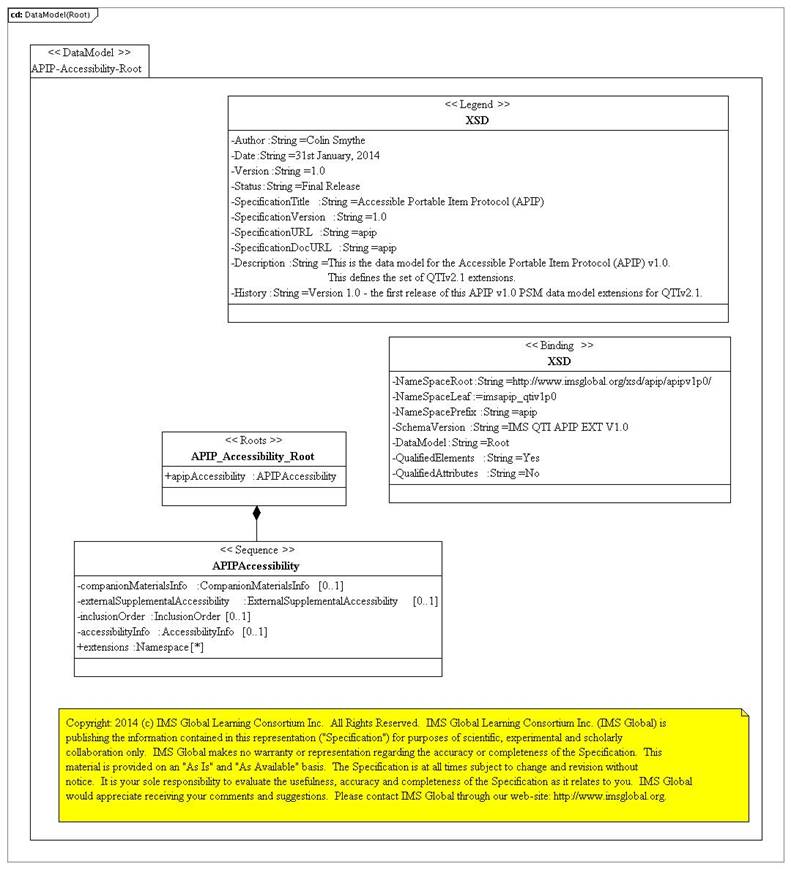
Figure 4.1 APIP accessibility root PSM.
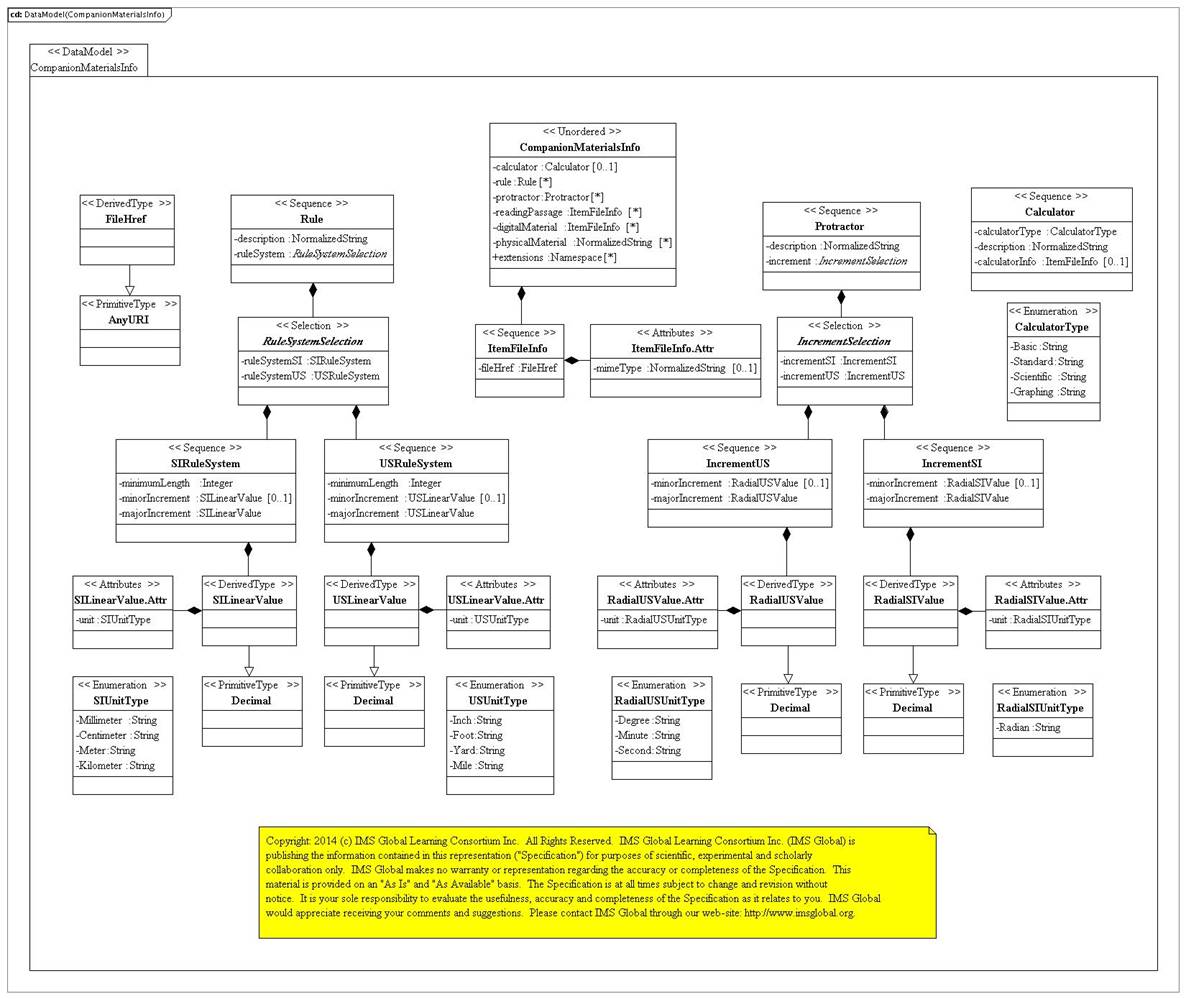
Figure 4.2 APIP Companion materials information PSM.
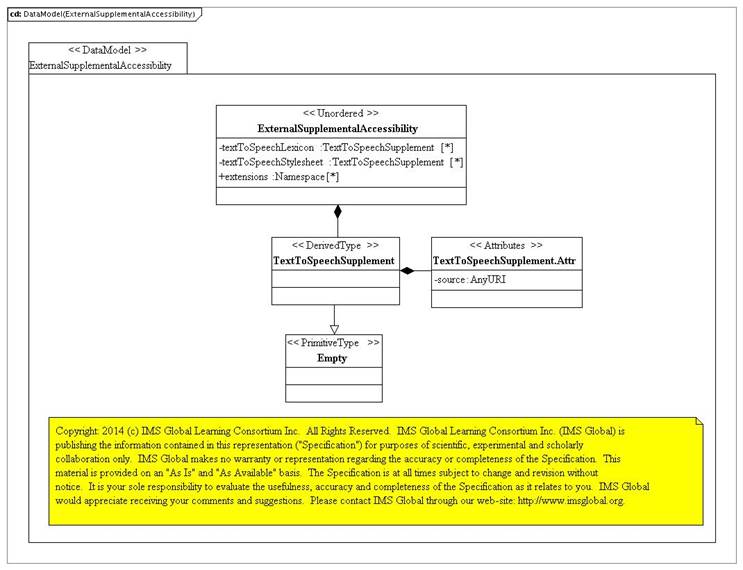
Figure 4.3 APIP External supplemental accessibility information PSM.
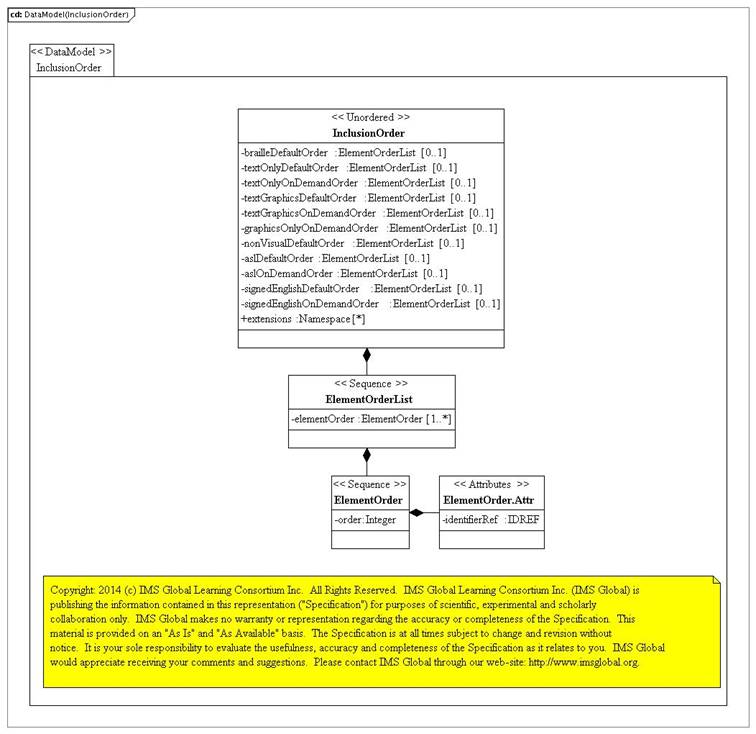
Figure 4.4 APIP inclusion order PSM.
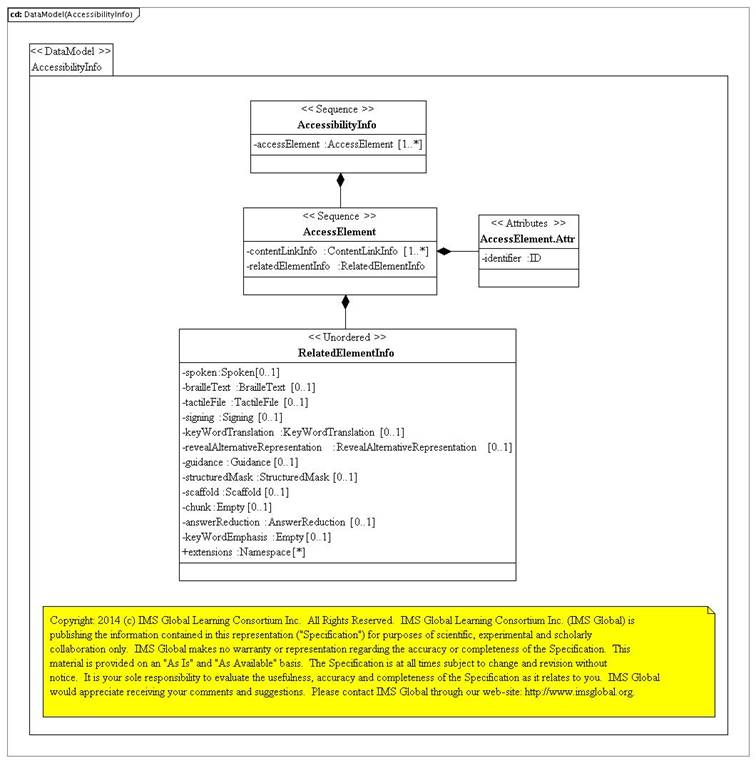
Figure 4.5 APIP accessibility information PSM.
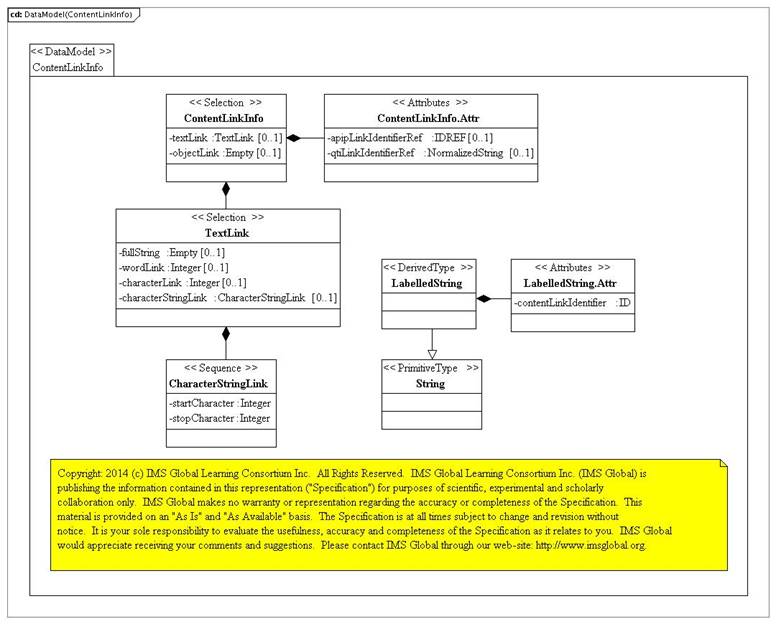
Figure 4.6 APIP content link information PSM.
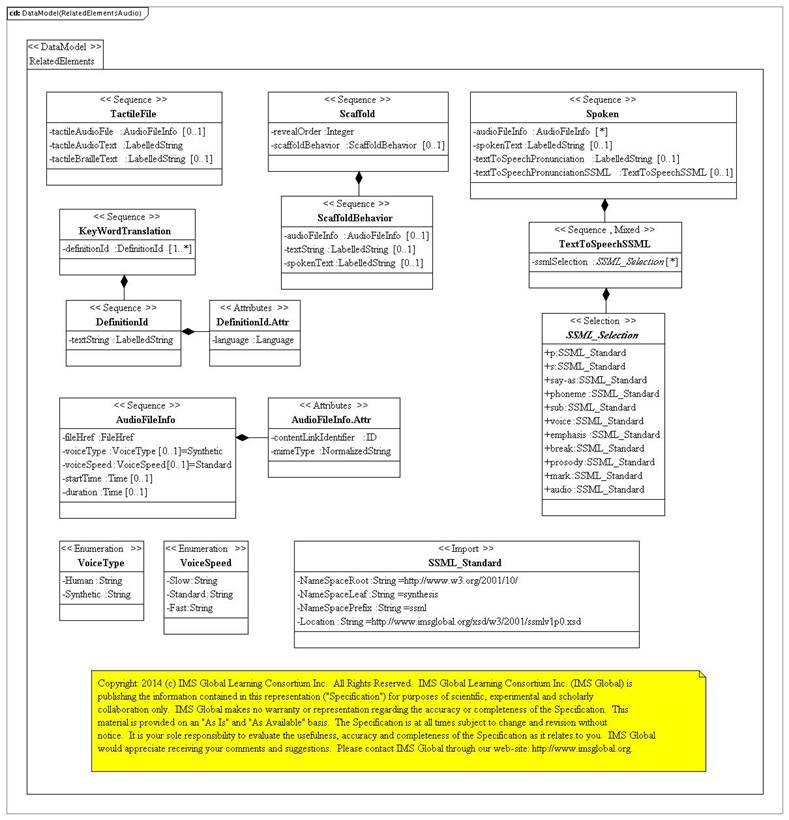
Figure 4.7 APIP audio-based accessibility information PSM.
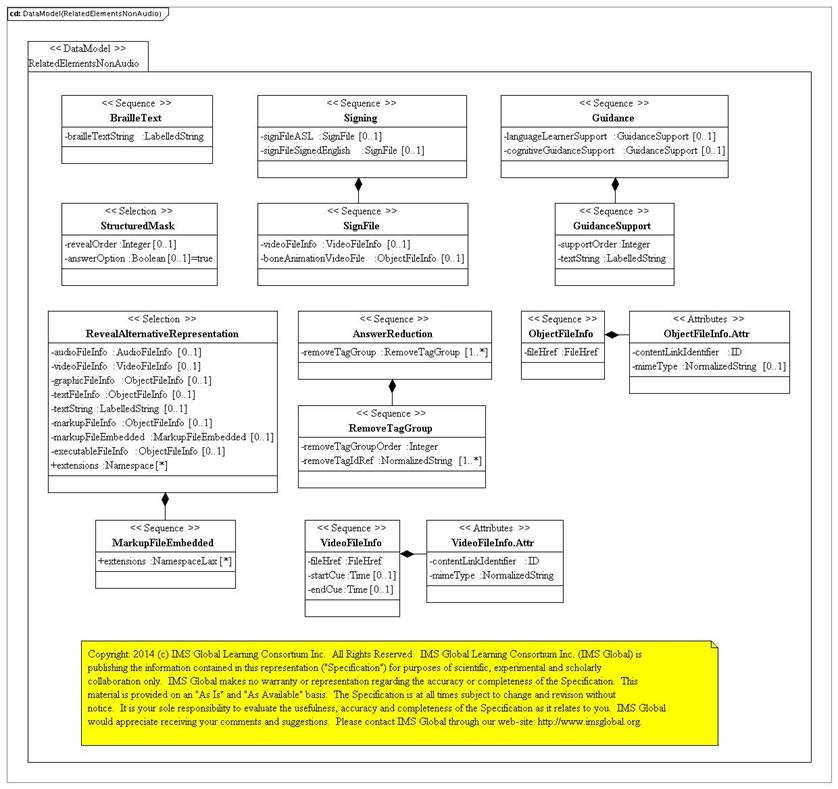
Figure 4.8 APIP non-audio-based accessibility information PSM.
4.2 Information Model to PMS to XSD Mappings
For the APIP QTI Extensions the mapping between the PIM (Information Model in Section 3) and PSM binding representation (Section 4.1) is detailed in Table 4.1. The key to Table 4.1 is:
· The ‘PSM Reference’ field refers to information in the PSM description (Section 4.1 in this document). The sub-fields are:
— Name – the name of the data structure in the PSM and PIM
— UML Type – the type of UML construct i.e. either Class or Attribute
— Figure – the reference Figure number in this document;
· The ‘PIM Reference’ field refers to the Information Model (Section 3). The sub-fields are:
— Type – the type of the data structure in the Information Model
— Table – the reference number of Tabular description in the corresponding Information Model document;
· The 'XSD Reference' field refers to information in the XSD descriptions (Section 4.1 in this document). The sub-fields are:
— Name – the name of the field in the XSD(s)
— Type – the type of XSD construct i.e. either a ComplexType or Element. In the case of a ComplexType there are two sub-divisions of sequence, ComplexType (S), choice, ComplexType (C) and unordered, ComplexType (U).
Table 4.1 Mapping between the PIM (Information Model), PSM (Binding) and XSD descriptions for the APIP QTI Extensions.
|
PSM (Binding) Reference |
PIM (Information) Reference |
XSD Reference |
||||
|---|---|---|---|---|---|---|
|
Name |
UML Type |
Figure |
Type |
Table |
Name |
Type |
|
AssessmentItem |
Class |
– |
– |
See [APIP, 14b] |
– |
– |
|
RubricBlock |
Class |
– |
– |
See [APIP, 14b] |
– |
– |
|
FeedbackBlock |
Class |
– |
– |
See [APIP, 14b] |
– |
– |
|
TemplateBlock |
Class |
– |
– |
See [APIP, 14b] |
– |
– |
|
· apipAccessibility |
Attribute |
4.1 |
APIPAccessibility |
3.2 |
apipAccessibility |
Element |
|
APIPAccessibility |
Class |
4.1 |
– |
3.3 |
APIPAccessibility.Type |
ComplexType (S) |
|
· companionMaterialsInfo |
Attribute |
4.1 |
CompanionMaterialsInfo |
3.4 |
companionMaterialsInfo |
Element |
|
· externalSupplemental |
Attribute |
4.1 |
ExternalSupplemental |
3.5 |
externalSupplementalAccessibility |
Element |
|
· inclusionOrder |
Attribute |
4.1 |
InclusionOrder |
3.6 |
inclusionOrder |
Element |
|
· accessibilityInfo |
Attribute |
4.1 |
AccessibilityInfo |
3.7 |
accessibilityInfo |
Element |
|
· extensions |
Attribute |
4.1 |
Unspecified |
3.8 |
Namespace Extension Group |
Namespace |
|
CompanionMaterialsInfo |
Class |
4.2 |
– |
3.9 |
CompanionMaterialsInfo.Type |
ComplexType (U) |
|
· calculator |
Attribute |
4.2 |
Calculator |
3.10 |
calculator |
Element |
|
· rule |
Attribute |
4.2 |
Rule |
3.11 |
rule |
Element |
|
· protractor |
Attribute |
4.2 |
Protractor |
3.12 |
protractor |
Element |
|
· digitalMaterial |
Attribute |
4.2 |
ItemFileInfo |
3.13 |
digitalMaterial |
Element |
|
· physicalMaterial |
Attribute |
4.2 |
NormalizedString |
3.14 |
physicalMaterial |
Element |
|
· readingPassage |
Attribute |
4.2 |
ItemFileInfo |
3.15 |
readingPassage |
Element |
|
· extensions |
Attribute |
4.1 |
Unspecified |
3.16 |
Namespace Extension Group |
Namespace |
|
Calculator |
Class |
4.2 |
– |
3.17 |
Calculator.Type |
ComplexType (S) |
|
· calculatorType |
Attribute |
4.2 |
Enumerated |
3.18 |
calculatorType |
Element |
|
· description |
Attribute |
4.2 |
NormalizedString |
3.19 |
description |
Element |
|
· calculatorInfo |
Attribute |
4.2 |
ItemFileInfo |
3.20 |
calculatorInfo |
Element |
|
Rule |
Class |
4.2 |
– |
3.23 |
Rule.Type |
ComplexType (S) |
|
· description |
Attribute |
4.2 |
NormalizedString |
3.24 |
description |
Element |
|
· ruleSystemSI |
Attribute |
4.2 |
SIRuleSystem |
3.25 |
ruleSystemSI |
Element |
|
· ruleSystemUS |
Attribute |
4.2 |
USRuleSystem |
3.26 |
ruleSyetmUS |
Element |
|
SIRuleSystem |
Class |
4.2 |
– |
3.27 |
SIRuleSystem.Type |
ComplexType (S) |
|
· minimumLength |
Attribute |
4.2 |
Integer |
3.28 |
length |
Element |
|
· minorIncrement |
Attribute |
4.2 |
SILinearValue |
3.29 |
minorIncrement |
Element |
|
· majorIncrement |
Attribute |
4.2 |
SILinearValue |
3.30 |
majorIncrement |
Element |
|
SILinearValue |
Class |
4.2 |
Decimal |
3.31 |
SILinearValue.Type |
ComplexType (S) |
|
· unit |
Attribute |
4.2 |
Enumerated |
3.32 |
unit |
Attribute |
|
USRuleSystem |
Class |
4.2 |
– |
3.33 |
USRuleSystem.Type |
ComplexType (S) |
|
· minimumLength |
Attribute |
4.2 |
Integer |
3.34 |
length |
Element |
|
· minorIncrement |
Attribute |
4.2 |
USLinearValue |
3.35 |
minorIncrement |
Element |
|
· majorIncrement |
Attribute |
4.2 |
USLinearValue |
3.36 |
majorIncrement |
Element |
|
USLinearValue |
Class |
4.2 |
Decimal |
3.37 |
USLinearValue.Type |
ComplexType (S) |
|
· unit |
Attribute |
4.2 |
Enumerated |
3.38 |
unit |
Attribute |
|
Protractor |
Class |
4.2 |
– |
3.39 |
Protractor.Type |
ComplexType |
|
· description |
Attribute |
4.2 |
NormalizedString |
3.40 |
description |
Element |
|
· incrementSI |
Attribute |
4.2 |
IncrementSI |
3.41 |
incrementSI |
Element |
|
· incrementUS |
Attribute |
4.2 |
IncrementUS |
3.42 |
incrementUS |
Element |
|
IncrementUS |
Class |
4.2 |
– |
3.43 |
Protractor.Type |
ComplexType |
|
· minorIncrement |
Attribute |
4.2 |
RadialUSValue |
3.44 |
minorIncrement |
Element |
|
· majorIncrement |
Attribute |
4.2 |
RadialUSValue |
3.45 |
majorIncrement |
Element |
|
RadialUSValue |
Class |
4.2 |
Decimal |
3.46 |
RadialUSValue.Type |
ComplexType (S) |
|
· unit |
Attribute |
4.2 |
Enumerated |
3.47 |
unit |
Attribute |
|
IncrementSI |
Class |
4.2 |
– |
3.48 |
Protractor.Type |
ComplexType |
|
· minorIncrement |
Attribute |
4.2 |
RadialSIValue |
3.49 |
minorIncrement |
Element |
|
· majorIncrement |
Attribute |
4.2 |
RadialSIValue |
3.50 |
majorIncrement |
Element |
|
RadialSIValue |
Class |
4.2 |
Decimal |
3.51 |
RadialUSValue.Type |
ComplexType (S) |
|
· unit |
Attribute |
4.2 |
Enumerated |
3.52 |
unit |
Attribute |
|
ItemFileInfo |
Class |
4.2 |
– |
3.21 |
ItemFileInfo.Type |
ComplexType (S) |
|
· fileHref |
Attribute |
4.2 |
FileHref |
3.22 |
fileHref |
Element |
|
ExternalSupplementalAccessibility |
Class |
4.3 |
– |
3.53 |
ExternalSupplemental |
ComplexType (U) |
|
· textToSpeechLexicon |
Attribute |
4.3 |
TextToSpeechLexicon |
3.54 |
textToSpeechLexicon |
Element |
|
· textToSpeechStylesheet |
Attribute |
4.3 |
TextToSpeechStylesheet |
3.55 |
textToSpeechStylesheet |
Element |
|
· extensions |
Attribute |
4.3 |
Unspecified |
3.56 |
Namespace Extension Group |
Namespace |
|
TextToSpeechSupplement |
Class |
4.3 |
– |
3.57 |
TextToSpeechSupplement.Type |
ComplexType (S) |
|
· source |
Attribute |
4.3 |
URI |
3.58 |
source |
Attribute |
|
InclusionOrder |
Class |
4.4 |
– |
3.59 |
InclusionOrder.Type |
ComplexType (U) |
|
· brailleDefaultOrder |
Attribute |
4.4 |
ElementOrderList |
3.60 |
textOnlyDefaultOrder |
Element |
|
· textOnlyDefaultOrder |
Attribute |
4.4 |
ElementOrderList |
3.61 |
textOnlyDefaultOrder |
Element |
|
· textOnlyOnDemandOrder |
Attribute |
4.4 |
ElementOrderList |
3.62 |
textOnlyOnDemandOrder |
Element |
|
· textGraphicsDefaultOrder |
Attribute |
4.4 |
ElementOrderList |
3.63 |
textGraphicsDefaultOrder |
Element |
|
· textGraphicsOnDemandOrder |
Attribute |
4.4 |
ElementOrderList |
3.64 |
textGraphicsOnDemandOrder |
Element |
|
· graphicsOnlyOnDemandOrder |
Attribute |
4.4 |
ElementOrderList |
3.65 |
graphicsOnlyOnDemandOrder |
Element |
|
· nonVisualDefaultOrder |
Attribute |
4.4 |
ElementOrderList |
3.66 |
nonVisualDefaultOrder |
Element |
|
· aslDefaultOrder |
Attribute |
4.4 |
ElementOrderList |
3.67 |
aslDefaultOrder |
Element |
|
· aslOnDemandOrder |
Attribute |
4.4 |
ElementOrderList |
3.68 |
aslOnDemandOrder |
Element |
|
· signedEnglishDefaultOrder |
Attribute |
4.4 |
ElementOrderList |
3.69 |
signedEnglishDefaultOrder |
Element |
|
· signedEnglishOnDemandOrder |
Attribute |
4.4 |
ElementOrderList |
3.70 |
signedEnglishOnDemandOrder |
Element |
|
· extensions |
Attribute |
4.4 |
Unspecified |
3.71 |
Namespace Extension Group |
Namespace |
|
ElementOrderList |
Class |
4.4 |
– |
3.72 |
ElementOrderList.Type |
ComplexType (S) |
|
· elementOrder |
Attribute |
4.4 |
ElementOrder |
3.73 |
elementOrder |
Element |
|
ElementOrder |
Class |
4.4 |
– |
3.74 |
ElementOrder.Type |
ComplexType (S) |
|
· identifierRef |
Attribute |
4.4 |
LUIDRef |
3.75 |
identifierRef |
Attribute |
|
· order |
Attribute |
4.4 |
Integer |
3.76 |
order |
Element |
|
AccessibilityInfo |
Class |
4.5 |
– |
3.77 |
AccessibilityInfo.Type |
ComplexType (S) |
|
· accessElement |
Attribute |
4.5 |
AccessElement |
3.78 |
accessElement |
Element |
|
AccessElement |
Class |
4.5 |
– |
3.79 |
AccessElement.Type |
ComplexType (S) |
|
· identifier |
Attribute |
4.5 |
LUID |
3.80 |
identifier |
Attribute |
|
· contentLinkInfo |
Attribute |
4.5 |
ContentLinkInfo |
3.81 |
contentLinkInfo |
Element |
|
· relatedElementInfo |
Attribute |
4.5 |
RelatedElementInfo |
3.82 |
relatedElementInfo |
Element |
|
ContentLinkInfo |
Class |
4.6 |
– |
3.83 |
ContentLinkInfo.Type |
ComplexType (S) |
|
· apipLinkIdentifierRef |
Attribute |
4.6 |
LUIDRef |
3.84 |
apipLinkIdentifierRef |
Element |
|
· qtiLinkIdentifierRef |
Attribute |
4.6 |
NormalizedString |
3.85 |
qtiLinkIdentifierRef |
Element |
|
· textLink |
Attribute |
4.6 |
TextLink |
3.86 |
textLink |
Element |
|
· objectLink |
Attribute |
4.6 |
Empty |
3.87 |
objectLink |
Element |
|
TextLink |
Class |
4.6 |
– |
3.88 |
Textlink.Type |
ComplexType (S) |
|
· fullString |
Attribute |
4.6 |
Empty |
3.89 |
fullString |
Element |
|
· wordLink |
Attribute |
4.6 |
Integer |
3.90 |
wordLink |
Element |
|
· characterLink |
Attribute |
4.6 |
Integer |
3.91 |
characterLink |
Element |
|
· CharacterStringLink |
Attribute |
4.6 |
CharacterStringLink |
3.92 |
characterStringLink |
Element |
|
CharacterStringLink |
Class |
4.6 |
– |
3.93 |
CharacterStringLink.Type |
ComplexType (S) |
|
· startCharacter |
Attribute |
4.6 |
Integer |
3.94 |
startCharacter |
Element |
|
· stopCharacter |
Attribute |
4.6 |
Integer |
3.95 |
stopCharacter |
Element |
|
RelatedElementInfo |
Class |
4.5 |
– |
3.96 |
RelatedElement.Type |
ComplexType (U) |
|
· spoken |
Attribute |
4.5 |
Spoken |
3.97 |
spoken |
Element |
|
· brailleText |
Attribute |
4.5 |
BrailleText |
3.98 |
brailleText |
Element |
|
· tactileFile |
Attribute |
4.5 |
TactileFile |
3.99 |
tactileFile |
Element |
|
· signing |
Attribute |
4.5 |
Signing |
3.100 |
signing |
Element |
|
· keyWordTranslation |
Attribute |
4.5 |
KeyWordTranslation |
3.101 |
keyWordTranslation |
Element |
|
· revealAlternativeRepresentation |
Attribute |
4.5 |
revealAlternativeRepresentation |
3.102 |
revealAlternativeRepresentation |
Element |
|
· guidance |
Attribute |
4.5 |
Guidance |
3.103 |
guidance |
Element |
|
· structuredMask |
Attribute |
4.5 |
StructuredMask |
3.104 |
structuredMask |
Element |
|
· scaffold |
Attribute |
4.5 |
Scaffold |
3.105 |
scaffold |
Element |
|
· chunk |
Attribute |
4.5 |
Chunk |
3.106 |
chunk |
Element |
|
· answerReduction |
Attribute |
4.5 |
AnswerReduction |
3.107 |
answerReduction |
Element |
|
· keyWordEmphasis |
Attribute |
4.5 |
KeyWordEmphasis |
3.108 |
keyWordEmphasis |
Element |
|
· extensions |
Attribute |
4.5 |
Unspecified |
3.109 |
Namespace Extension Group |
Namespace |
|
Spoken |
Class |
4.7 |
– |
3.110 |
Spoken.Type |
ComplexType (S) |
|
· audioFileInfo |
Attribute |
4.7 |
AudioFileInfo |
3.111 |
audioFileInfo |
Element |
|
· spokenText |
Attribute |
4.7 |
LabelledString |
3.112 |
spokenText |
Element |
|
· textToSpeechPronunciation |
Attribute |
4.7 |
LabelledString |
3.113 |
textToSpeechPronunciation |
Element |
|
· textToSpeechPronunciationML |
Attribute |
4.7 |
TexToSpeechSSML |
3.114 |
textToSpeechPronunciationSSML |
Element |
|
TextToSpeechSSML |
Class |
4.7 |
– |
3.115 |
TextToSpeechSSML.Type |
ComplexType (S/C/Mixed) |
|
· p |
Attribute |
4.7 |
– |
See [SSML, 11] |
– |
– |
|
· s |
Attribute |
4.7 |
– |
See [SSML, 11] |
– |
– |
|
· say-as |
Attribute |
4.7 |
– |
See [SSML, 11] |
– |
– |
|
· phoneme |
Attribute |
4.7 |
– |
See [SSML, 11] |
– |
– |
|
· sub |
Attribute |
4.7 |
– |
See [SSML, 11] |
– |
– |
|
· voice |
Attribute |
4.7 |
– |
See [SSML, 11] |
– |
– |
|
· emphasis |
Attribute |
4.7 |
– |
See [SSML, 11] |
– |
– |
|
· break |
Attribute |
4.7 |
– |
See [SSML, 11] |
– |
– |
|
· prosody |
Attribute |
4.7 |
– |
See [SSML, 11] |
– |
– |
|
· mark |
Attribute |
4.7 |
– |
See [SSML, 11] |
– |
– |
|
· audio |
Attribute |
4.7 |
– |
See [SSML, 11] |
– |
– |
|
BrailleText |
Class |
48 |
– |
3.116 |
BrailleText.Type |
ComplexType (S) |
|
· brailleTextString |
Attribute |
4.8 |
LabelledString |
3.117 |
brailleTextString |
Element |
|
TactileFile |
Class |
4.7 |
– |
3.118 |
TactileFile.Type |
ComplexType (S) |
|
· tactileAudioFile |
Attribute |
4.7 |
AudioFileInfo |
3.119 |
tactileAudioFile |
Element |
|
· tactileAudioText |
Attribute |
4.7 |
LabelledString |
3.120 |
tactileAudioText |
Element |
|
· tactileBrailleText |
Attribute |
4.7 |
LabelledString |
3.121 |
tactileBrailleText |
Element |
|
Signing |
Class |
4.8 |
– |
3.122 |
Signing.Type |
ComplexType (S) |
|
· signFileASL |
Attribute |
4.8 |
SignFile |
3.123 |
signFileASL |
Element |
|
· signFileSignedEnglish |
Attribute |
4.8 |
SignFile |
3.124 |
signFileSignedEnglish |
Element |
|
SignFile |
Class |
4.8 |
– |
3.125 |
SignFile.Type |
ComplexType (S) |
|
· videoFileInfo |
Attribute |
4.8 |
VideoFileInfo |
3.126 |
videoFileInfo |
Element |
|
· boneAnimationVideoFile |
Attribute |
4.8 |
ObjectFileInfo |
3.127 |
boneAnimationVideoFile |
Element |
|
KeyWordTranslation |
Class |
4.7 |
– |
3.128 |
KeyWordTranslation.Type |
ComplexType (S) |
|
· definitionId |
Attribute |
4.7 |
DefinitionId |
3.129 |
definitionId |
Element |
|
DefinitionId |
Class |
4.7 |
– |
3.130 |
DefinitionId.Type |
ComplexType (S) |
|
· language |
Attribute |
4.7 |
Language |
3.131 |
language |
Attribute |
|
· textString |
Attribute |
4.7 |
LabelledString |
3.132 |
textString |
Element |
|
RevealAlternativeRepresentation |
Class |
4.8 |
– |
3.133 |
RevealAlternativeRepresentation.Type |
ComplexType (C) |
|
· audioFileInfo |
Attribute |
4.8 |
AudioFileInfo |
3.134 |
audioFileInfo |
Element |
|
· videoFileInfo |
Attribute |
4.8 |
VideoFileInfo |
3.135 |
videoFileInfo |
Element |
|
· graphicFileInfo |
Attribute |
4.8 |
ObjectFileInfo |
3.136 |
graphicFileInfo |
Element |
|
· textFileInfo |
Attribute |
4.8 |
ObjectFileInfo |
3.137 |
textFileInfo |
Element |
|
· textString |
Attribute |
4.8 |
LabelledString |
3.138 |
tetString |
Element |
|
· markupFileInfo |
Attribute |
4.8 |
ObjectFileInfo |
3.139 |
markupFileInfo |
Element |
|
· markupFileEmbedded |
Attribute |
4.8 |
MarkupFileEmbedded |
3.140 |
markupFileEmbedded |
Element |
|
· flashFileInfo |
Attribute |
4.8 |
ObjectFileInfo |
3.141 |
flashFileInfo |
Element |
|
· extensions |
Attribute |
4.8 |
Unspecified |
3.142 |
Namespace Extension Group |
Namespace |
|
MarkupFileEmbedded |
Class |
4.8 |
– |
3.143 |
MarkupFileEmbedded.Type |
ComplexType (S) |
|
· extensions |
Attribute |
4.8 |
Unspecified |
3.144 |
Namespace Extension Group |
Namespace |
|
Guidance |
Class |
4.8 |
– |
3.145 |
Guidance.Type |
ComplexType (S) |
|
· languageLearnerSupport |
Attribute |
4.8 |
GuidanceSupport |
3.146 |
languageLearnerSupport |
Element |
|
· cognitiveGuidanceSupport |
Attribute |
4.8 |
GuidanceSupport |
3.147 |
cognitiveGuidanceSupport |
Element |
|
GuidanceSupport |
Class |
4.8 |
– |
3.148 |
Guidance.Type |
ComplexType (S) |
|
· supportOrder |
Attribute |
4.8 |
Integer |
3.149 |
supportOrder |
Element |
|
· textString |
Attribute |
4.8 |
LabelledString |
3.150 |
textString |
Element |
|
StructuredMask |
Class |
4.8 |
– |
3.151 |
StructuredMask.Type |
ComplexType (S) |
|
· revealOrder |
Attribute |
4.8 |
Integer |
3.152 |
revealOrder |
Element |
|
· answerOption |
Attribute |
4.8 |
Boolean |
3.153 |
answerOption |
Element |
|
Scaffold |
Class |
4.7 |
– |
3.154 |
Scaffold.Type |
ComplexType (S) |
|
· revealOrder |
Attribute |
4.7 |
Integer |
3.155 |
revealOrder |
Element |
|
· scaffoldBehavior |
Attribute |
4.7 |
ScaffoldBehavior |
3.156 |
scaffoldBehavior |
Element |
|
ScaffoldBehavior |
Class |
4.7 |
– |
3.157 |
ScaffoldBehavior.Type |
ComplexType (S) |
|
· audioFileInfo |
Attribute |
4.7 |
AudioFileInfo |
3.158 |
audioFileInfo |
Element |
|
· textString |
Attribute |
4.7 |
LabelledString |
3.159 |
textString |
Element |
|
· spokenText |
Attribute |
4.7 |
LabelledString |
3.160 |
spokenText |
Element |
|
AnswerReduction |
Class |
4.8 |
– |
3.161 |
AnswerReduction.Type |
ComplexType (S) |
|
· removeTagGroup |
Attribute |
4.8 |
RemoveTagGroup |
3.162 |
removeTagGroup |
Element |
|
RemoveTagGroup |
Class |
4.8 |
– |
3.163 |
RemoveTagGroup.Type |
ComplexType (S) |
|
· removeTagGroupOrder |
Attribute |
4.8 |
Integer |
3.164 |
removeTagGroupOrder |
Element |
|
· removeTagIdRef |
Attribute |
4.8 |
NormalizedString |
3.165 |
removeTagIdRef |
Element |
|
LabelledString |
Class |
4.6 |
String |
3.166 |
LabelledString.Type |
ComplexType (S) |
|
· contentLinkIdentifier |
Attribute |
4.6 |
LUID |
3.167 |
contentLinkIdentifier |
Attribute |
|
AudioFileInfo |
Class |
4.7 |
– |
3.168 |
AudioFileInfo.Type |
ComplexType (S) |
|
· contentLinkIdentifier |
Attribute |
4.7 |
LUID |
3.169 |
contentLinkIdentifier |
Attribute |
|
· mimeType |
Attribute |
4.7 |
NormalizedString |
3.170 |
mimeType |
Attribute |
|
· fileHref |
Attribute |
4.7 |
FileHref |
3.171 |
fileHref |
Element |
|
· voiceType |
Attribute |
4.7 |
Enumerated |
3.172 |
voiceType |
Element |
|
· voiceSpeed |
Attribute |
4.7 |
Enumerated |
3.173 |
voiceSpeed |
Element |
|
· startTime |
Attribute |
4.7 |
Time |
3.174 |
startTime |
Element |
|
· duration |
Attribute |
4.7 |
Time |
3.175 |
duration |
Element |
|
VideoFileInfo |
Class |
4.8 |
– |
3.176 |
VideoFileInfo.Type |
ComplexType (S) |
|
· contentLinkIdentifier |
Attribute |
4.8 |
LUID |
3.177 |
contentLinkIdentifier |
Attribute |
|
· mimeType |
Attribute |
4.8 |
NormalizedString |
3.178 |
mimeType |
Attribute |
|
· fileHref |
Attribute |
4.8 |
FileHref |
3.179 |
fileHref |
Element |
|
· startCue |
Attribute |
4.8 |
Time |
3.180 |
startCue |
Element |
|
· endCue |
Attribute |
4.8 |
Time |
3.181 |
endCue |
Element |
|
ObjectFileInfo |
Class |
4.8 |
– |
3.182 |
ObjectFileInfo.Type |
ComplexType (S) |
|
· contentLinkIdentifier |
Attribute |
4.8 |
LUID |
3.183 |
contentLinkIdentifier |
Attribute |
|
· mimeType |
Attribute |
4.8 |
NormalizedString |
3.184 |
mimeType |
Attribute |
|
· fileHref |
Attribute |
4.8 |
FileHref |
3.185 |
fileHref |
Element |
4.3 XSD Listing
The XSD for the APIP QTI extensions information model is available in the file:
· ‘apipv1p0_qtiextv2p1_v1p0.xsd’.
This XSD was created by using the I-BAT v0.9.5 on the PSM (shown in sub-section 4.1).
This XSD should be used in conjunction with the profiled version of the 1EdTech QTI v2.1 specification available in the files:
· ‘apipv1p0_qtiitemv2p1_v1p0.xsd’;
· ‘apipv1p0_qtisectionv2p1_v1p0.xsd’.
The extensions are inserted into the profiled QTI using a name-spacing approach.
Appendix A The 1EdTech UML Profile Notation
The APIP Information Models are expressed using the standard 1EdTech representation in the Unified Modeling Language (UML). Classes in this information model are classified into one of four types. These abstractions are bound to specific data structures for machine processing in the associated bindings. The abstract class types are:
· Unordered, Sequence, or Selection: A container class may be a parent of one or more child classes (the Parent/Child notation is used to indicate the nature of the relationship as distinct from inheritance i.e. this does not denote any form of inheritance). The ‘Unordered’ container does not require the order of the contained attributes to be maintained, the ‘Sequence’ container denotes information whose order must be maintained and the ‘Selection’ container denotes a selection of the contained attributes;
· Value: A value class shall not be a parent. That is, it shall not be a composite of container, value, or unspecified class types. A value class shall always be a child of a container class and shall have semantic value within the scope of its parent class’s semantic value;
· PrimitiveType: This is a class that is used to denote a basic data-type for the specification;
· Unspecified: An unspecified class may be a parent. An unspecified class serves as an extension point for this Information Model.
Table A1.1 lists the class and attribute descriptors used to describe the abstract classes and definitions of the descriptors.
Table A1.1 Class and attribute descriptors
|
Descriptor |
Definition |
|---|---|
|
Class name |
The name given to the class being described. |
|
Class type |
The abstract class type of this class. |
|
Data type |
For value classes, the allowed structure for valid values for the class. Valid data types are: Boolean: The primitive, two-valued data type that uses the keywords “true” and “false” to indicate the logical state of an object. FileHref: This is the URI for a file. It has the same format as URI with a character length constraint of [1..4095]. HexBinary: This is a binary value coded in hexadecimal. The range supported is ‘00000000’ to ‘FFFFFFFF’. Integer: An integer. Language: This is the set of codes for language identification as defined by ISO 639-1 and ISO 639-2 coupled with the country code as defined by ISO 3166-1 (creating a language code-country code format). LUID: A locally unique identifier (it may also be a globally unique identifier). It is a sequence of printable characters that does not contain carriage returns or tabs. There is no length constraint but the smallest permitted maximum to be supported is 4095 characters. LUIDRef: Reference to a LUID that is defined within the same scope as the LUIDRef i.e. if a LUIDRef is defined, the associated LUID must also exist in the same scope. NormalizedString: A sequence of printable characters that does not contain carriage returns or tabs. There is no length constraint. Time: This is a time value as defined by ISO 8601 in the format of hh:mm:ss where ‘hh’ is the hours, ‘mm’ the minutes and ‘ss’ the seconds. URI: Any syntactically valid instance of a URI as defined in RFC3986. Note: Many of the foundational Specifications, Standards, and Recommendations referred to by this Information Model use RFC2396 and RFC2732 as the definitions of URI. These are made obsolete by RFC3986, but many of the foundational documents have not been updated to reference RFC3986. |
|
Value space |
The range of valid values for this class. If the value space is unspecified, it is not known or is not important. This value space must be defined in terms of the associated data-type. |
|
Multiplicity |
A property of a class indicating the number of times it may be used or appear in a given parent context. The values of this property are expressed as a range or shorthand for a range using this notation:
Multiplicities may also appear in short-hand notation in the UML models. The short-hand equivalents shall be (exclusive of bracketed comments):
Where multiplicity is greater than one, the importance of the ordering of siblings is also indicated by appending either “,”ordered or “,” unordered. ordered specifies a sequence of siblings as listed, unordered specifies a collection or bag of siblings for which the order is not important. The default value is unordered. |
|
Scope |
The scope of the attribute is define as either: · ‘-‘ denotes local; · ‘+’ denotes global. The appropriate symbol precedes the name of the attribute. |
|
Parents |
Lists classes that may be parents of this class. |
|
Children |
Lists the set of attributes and associations of this class in the form “[” child *“,” child “]”. One or more child classes may be expressed within square brackets. Each relationship in the list shall be separated by a comma. Where more than one child is listed, the importance of the ordering of siblings is also indicated by appending either “,”ordered or “,” unordered. ordered specifies a sequence of siblings as listed. unordered specifies a collection or bag of sibling for which the order is not important. The default value is unordered. |
|
Description |
Contains descriptions relating to the class and its values space. |
In general, this specification does not define the ways in which an end system must be realized. However, the required interoperability behavior requires that an end system have certain characteristics. The static properties of these characteristics are defined in this Section, including:
· When an attribute has a multiplicity of ‘1..1’, an end system must be capable of supporting one instance;
· When an attribute has a multiplicity of ‘1..*’, an end system must be capable of supporting at least one instance. The specification will also define the smallest permitted maximum number of instances that must also be supported by the end system;
· When an attribute has a multiplicity of ‘0..1’, an end system should support a single instance;
· When an attribute has a multiplicity of ‘0..*’, the specification will define the smallest permitted maximum number of instances that must also be supported by the end system.
About the Document
Title: 1EdTech Accessible Portable Item Protocol (APIP): Technical Specification for the QTIv2.1 Accessibility Features
Editors: Colin Smythe (1EdTech), Mark McKell (1EdTech) and Mike Russell (Measured Progress)
Co-chairs: Gary Driscoll (ETS), Thomas Hoffmann (Measured Progress) and Wayne Ostler (Pearson)
Version: 1.0
Version Date: 31 March 2014
Status: Final Specification
Summary: The aim of the APIP Project is to use well established e-learning interoperability standards to enable the exchange of accessible assessment content between computer-based assessment systems, tools and applications. Users of systems, tools and applications that adopt the APIP are able to use their accessible assessment content on a wide range of systems. This document contains the information model and binding description for the new features that extend the 1EdTech Question & Test Interoperability (QTI) v2.1 specification to support portable accessibility functionality for items and tests.
Revision Information: First release.
Purpose: This document is made available for adoption by the public community at large.
Document Location: http://www.imsglobal.org/apip/
List of Contributors
The following individuals contributed to the development of this document:
|
Rob Abel, 1EdTech (USA) |
Justin Marks, NWEA (USA) |
|
Michael Aumock, Pacific Metrics (USA) |
Mark McKell, 1EdTech (USA) |
|
Marty Christensen, ACT (USA) |
Sue Milne, JISC (UK) |
|
Jason Craft, Pearson (USA) |
Wayne Ostler, Pearson (USA) |
|
Gary Driscoll, ETS (USA) |
Zack Pierce, Measured Progress (USA) |
|
Eric Hansen, ETS (USA) |
Michelle Richard, Pearson (USA) |
|
Regina Hoag, ETS (USA) |
Mike Russell, Measured Progress (USA) |
|
Thomas Hoffmann, Measured Progress (USA) |
Farhat Siddiqui, ETS (USA) |
|
Wilbert Kraan, JISC (UK) |
Colin Smythe, 1EdTech (UK) |
|
Devin Loftis, McGraw-Hill/CTB (USA) |
Wyatt VanderStucken, ETS (USA) |
Revision History
|
Version No. |
Release Date |
Comments |
|
Final Specification V1.0 |
31 March 2014 |
The Final Specification version of this document. |
|
|
|
|
1EdTech Consortium, Inc. (“1EdTech”) is publishing the information contained in this document (“Specification”) for purposes of scientific, experimental, and scholarly collaboration only.
1EdTech makes no warranty or representation regarding the accuracy or completeness of the Specification.
This material is provided on an “As Is” and “As Available” basis.
The Specification is at all times subject to change and revision without notice.
It is your sole responsibility to evaluate the usefulness, accuracy, and completeness of the Specification as it relates to you.
1EdTech would appreciate receiving your comments and suggestions.
Please contact 1EdTech through our website at http://www.imsglobal.org.
Please refer to Document Name: 1EdTech APIP Technical Specification for QTIv2.1 Accessibility Features v1.0 Final Specification
Date: 31 March 2014


